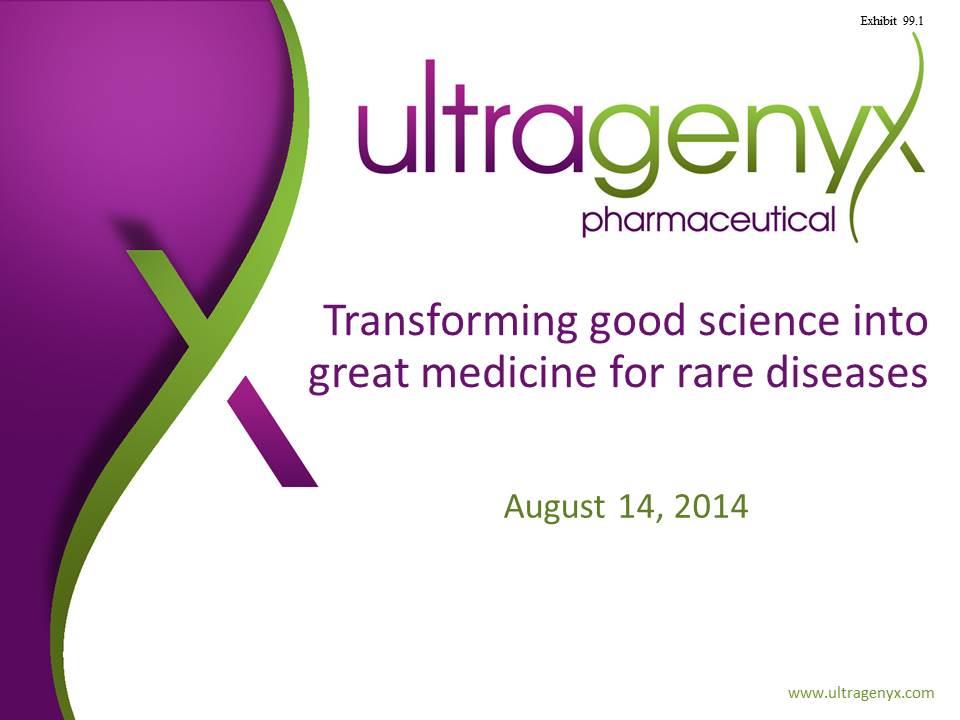
August 14, 2014 Transforming good science into great medicine for rare diseases Exhibit 99.1
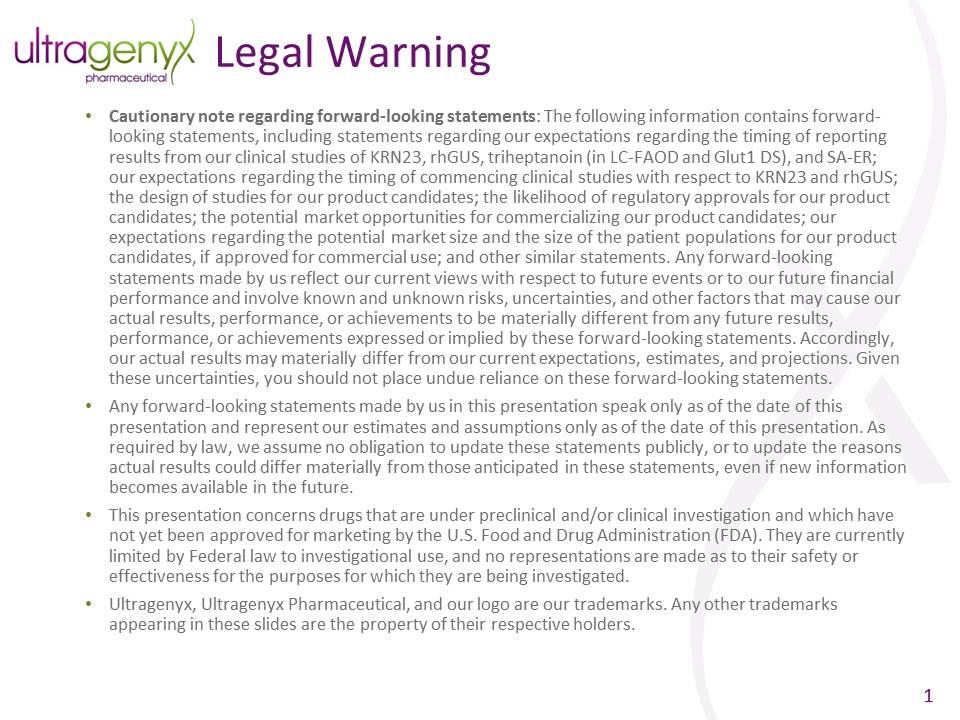
Cautionary note regarding forward-looking statements: The following information contains forward-looking statements, including statements regarding our expectations regarding the timing of reporting results from our clinical studies of KRN23, rhGUS, triheptanoin (in LC-FAOD and Glut1 DS), and SA-ER; our expectations regarding the timing of commencing clinical studies with respect to KRN23 and rhGUS; the design of studies for our product candidates; the likelihood of regulatory approvals for our product candidates; the potential market opportunities for commercializing our product candidates; our expectations regarding the potential market size and the size of the patient populations for our product candidates, if approved for commercial use; and other similar statements. Any forward-looking statements made by us reflect our current views with respect to future events or to our future financial performance and involve known and unknown risks, uncertainties, and other factors that may cause our actual results, performance, or achievements to be materially different from any future results, performance, or achievements expressed or implied by these forward-looking statements. Accordingly, our actual results may materially differ from our current expectations, estimates, and projections. Given these uncertainties, you should not place undue reliance on these forward-looking statements. Any forward-looking statements made by us in this presentation speak only as of the date of this presentation and represent our estimates and assumptions only as of the date of this presentation. As required by law, we assume no obligation to update these statements publicly, or to update the reasons actual results could differ materially from those anticipated in these statements, even if new information becomes available in the future. This presentation concerns drugs that are under preclinical and/or clinical investigation and which have not yet been approved for marketing by the U.S. Food and Drug Administration (FDA). They are currently limited by Federal law to investigational use, and no representations are made as to their safety or effectiveness for the purposes for which they are being investigated. Ultragenyx, Ultragenyx Pharmaceutical, and our logo are our trademarks. Any other trademarks appearing in these slides are the property of their respective holders. Legal Warning
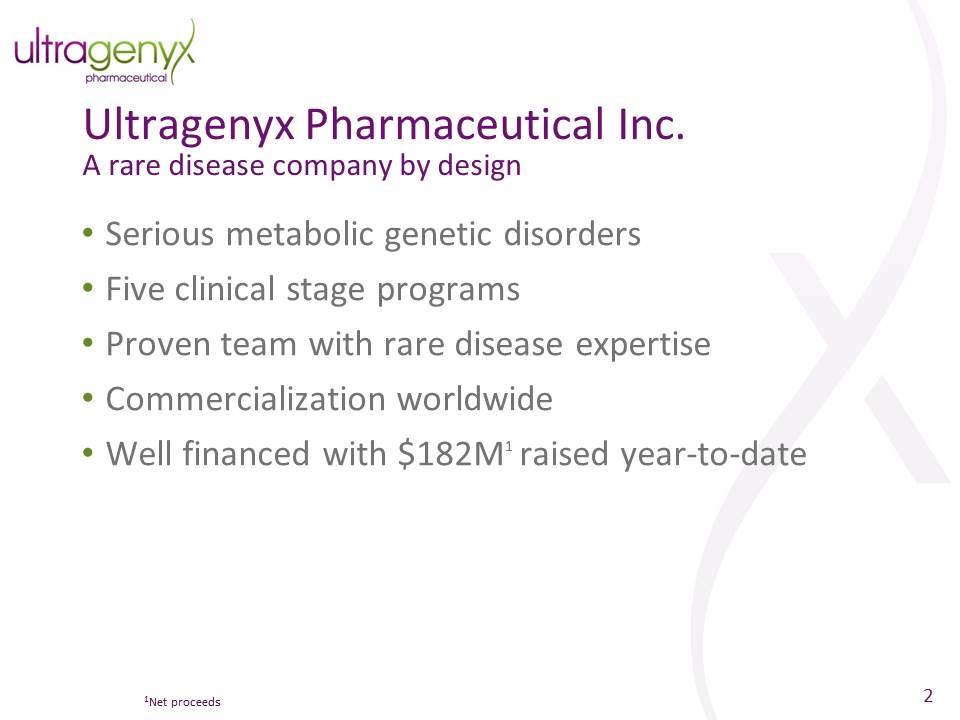
Ultragenyx Pharmaceutical Inc. A rare disease company by design Serious metabolic genetic disorders Five clinical stage programs Proven team with rare disease expertise Commercialization worldwide Well financed with $182M1 raised year-to-date 1Net proceeds
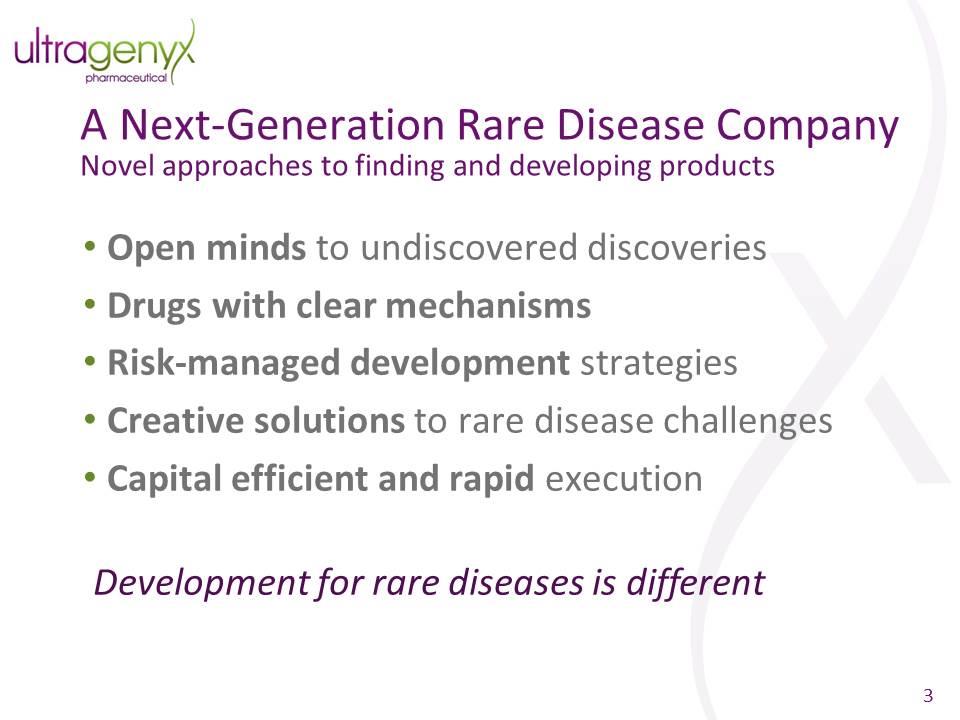
A Next-Generation Rare Disease Company Novel approaches to finding and developing products Open minds to undiscovered discoveries Drugs with clear mechanisms Risk-managed development strategies Creative solutions to rare disease challenges Capital efficient and rapid execution Development for rare diseases is different
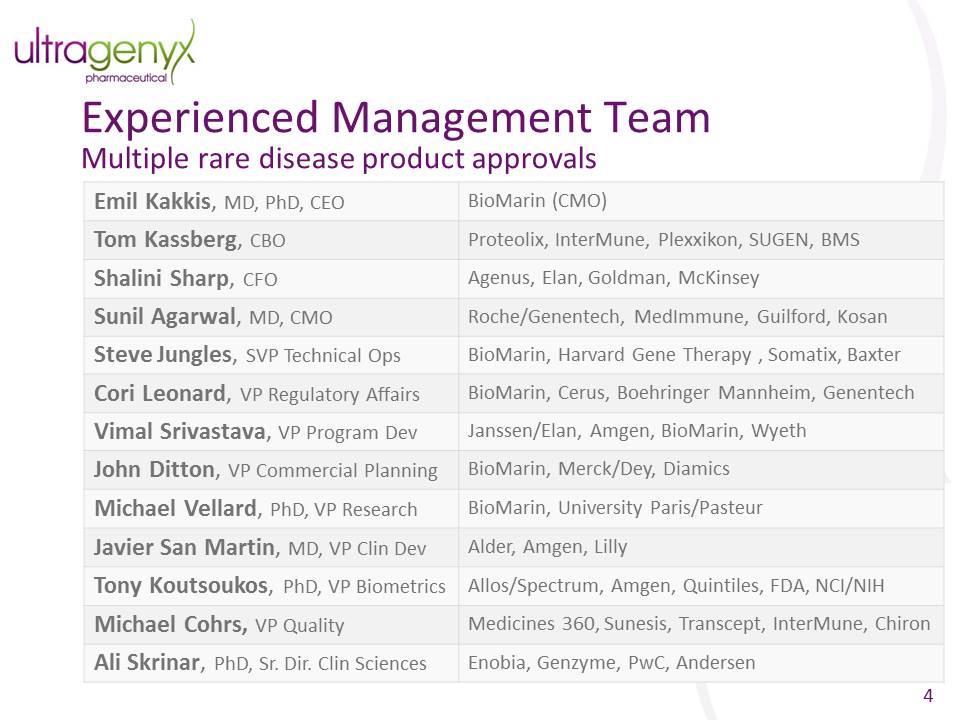
Experienced Management Team Multiple rare disease product approvals Emil Kakkis, MD, PhD, CEO BioMarin (CMO) Tom Kassberg, CBO Proteolix, InterMune, Plexxikon, SUGEN, BMS Shalini Sharp, CFO Agenus, Elan, Goldman, McKinsey Sunil Agarwal, MD, CMO Roche/Genentech, MedImmune, Guilford, Kosan Steve Jungles, SVP Technical Ops BioMarin, Harvard Gene Therapy , Somatix, Baxter Cori Leonard, VP Regulatory Affairs BioMarin, Cerus, Boehringer Mannheim, Genentech Vimal Srivastava, VP Program Dev Janssen/Elan, Amgen, BioMarin, Wyeth John Ditton, VP Commercial Planning BioMarin, Merck/Dey, Diamics Michael Vellard, PhD, VP Research BioMarin, University Paris/Pasteur Javier San Martin, MD, VP Clin Dev Alder, Amgen, Lilly Tony Koutsoukos, PhD, VP Biometrics Allos/Spectrum, Amgen, Quintiles, FDA, NCI/NIH Michael Cohrs, VP Quality Medicines 360, Sunesis, Transcept, InterMune, Chiron Ali Skrinar, PhD, Sr. Dir. Clin Sciences Enobia, Genzyme, PwC, Andersen
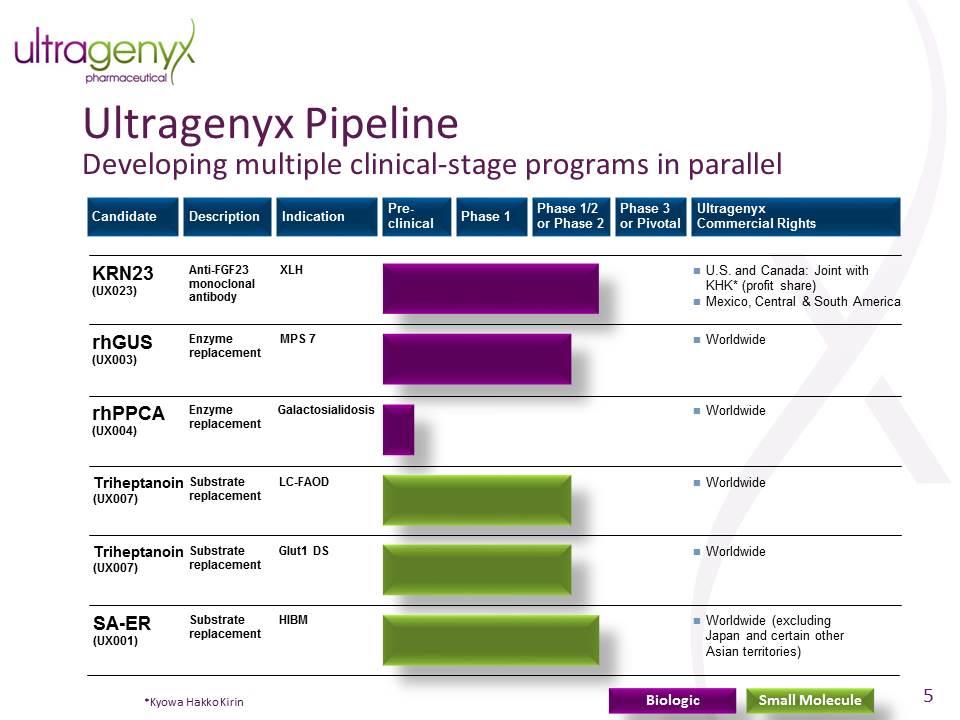
Ultragenyx Pipeline Developing multiple clinical-stage programs in parallel Phase 1/2 or Phase 2 Pre- clinical Candidate Ultragenyx Commercial Rights Phase 3 or Pivotal Phase 1 Indication rhPPCA (UX004) Worldwide Galactosialidosis rhGUS (UX003) MPS 7 Worldwide Triheptanoin (UX007) Glut1 DS Worldwide Triheptanoin (UX007) LC-FAOD Worldwide Description Enzyme replacement Enzyme replacement Substrate replacement Substrate replacement KRN23 (UX023) XLH U.S. and Canada: Joint with KHK* (profit share) Mexico, Central & South America Anti-FGF23 monoclonal antibody SA-ER (UX001) HIBM Worldwide (excluding Japan and certain other Asian territories) Substrate replacement *Kyowa Hakko Kirin Biologic Small Molecule
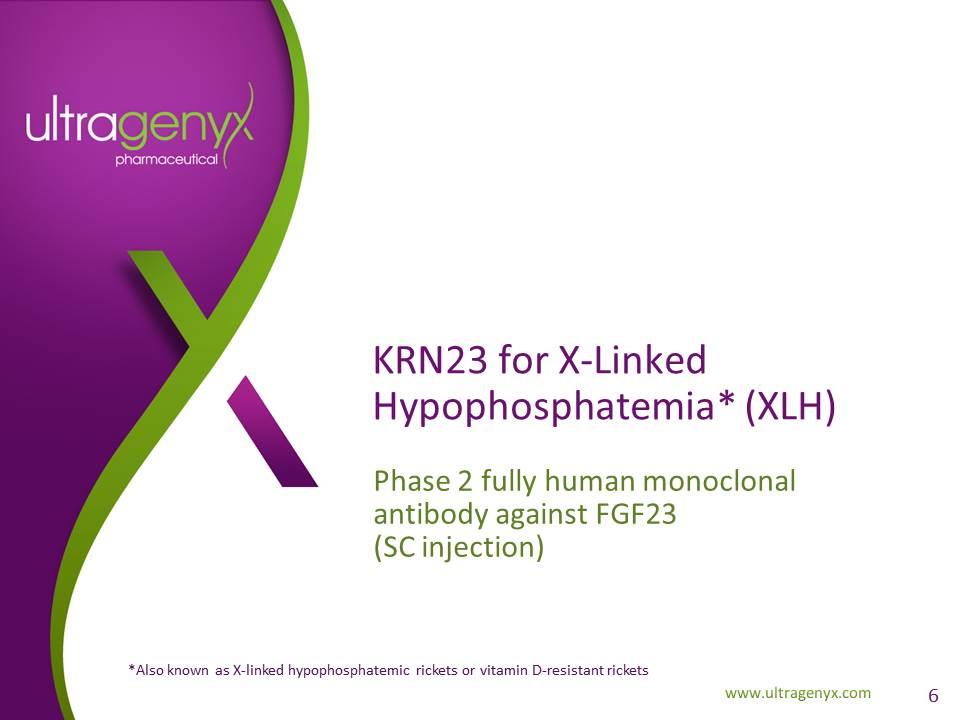
Phase 2 fully human monoclonal antibody against FGF23 (SC injection) KRN23 for X-Linked Hypophosphatemia* (XLH) *Also known as X-linked hypophosphatemic rickets or vitamin D-resistant rickets
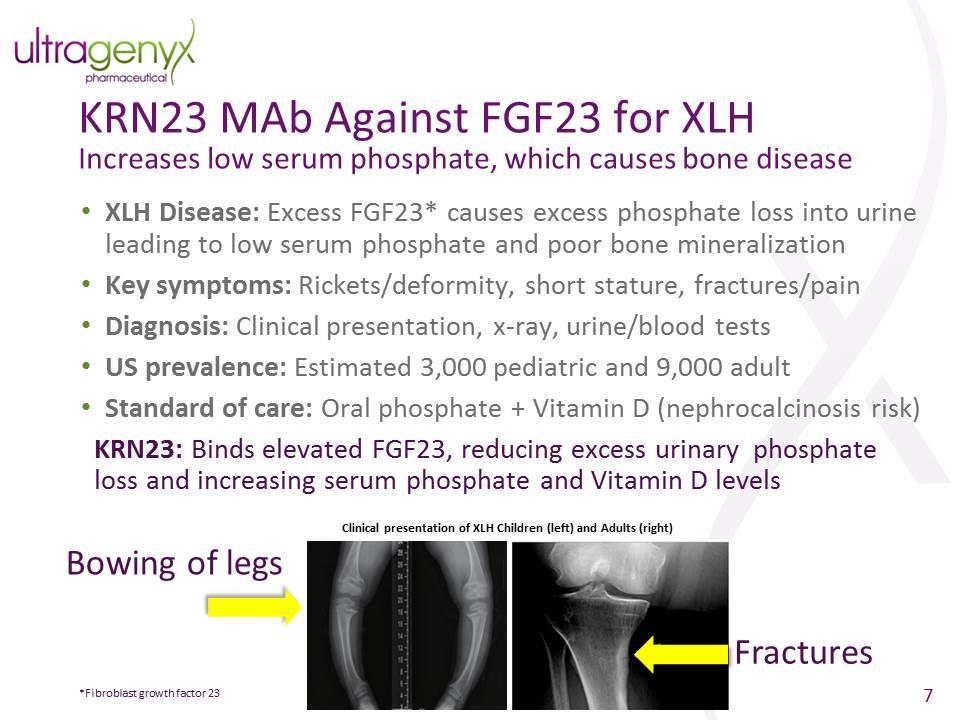
KRN23 MAb Against FGF23 for XLH Increases low serum phosphate, which causes bone disease XLH Disease: Excess FGF23* causes excess phosphate loss into urine leading to low serum phosphate and poor bone mineralization Key symptoms: Rickets/deformity, short stature, fractures/pain Diagnosis: Clinical presentation, x-ray, urine/blood tests US prevalence: Estimated 3,000 pediatric and 9,000 adult Standard of care: Oral phosphate + Vitamin D (nephrocalcinosis risk) KRN23: Binds elevated FGF23, reducing excess urinary phosphate loss and increasing serum phosphate and Vitamin D levels Fractures *Fibroblast growth factor 23 Bowing of legs Clinical presentation of XLH Children (left) and Adults (right)
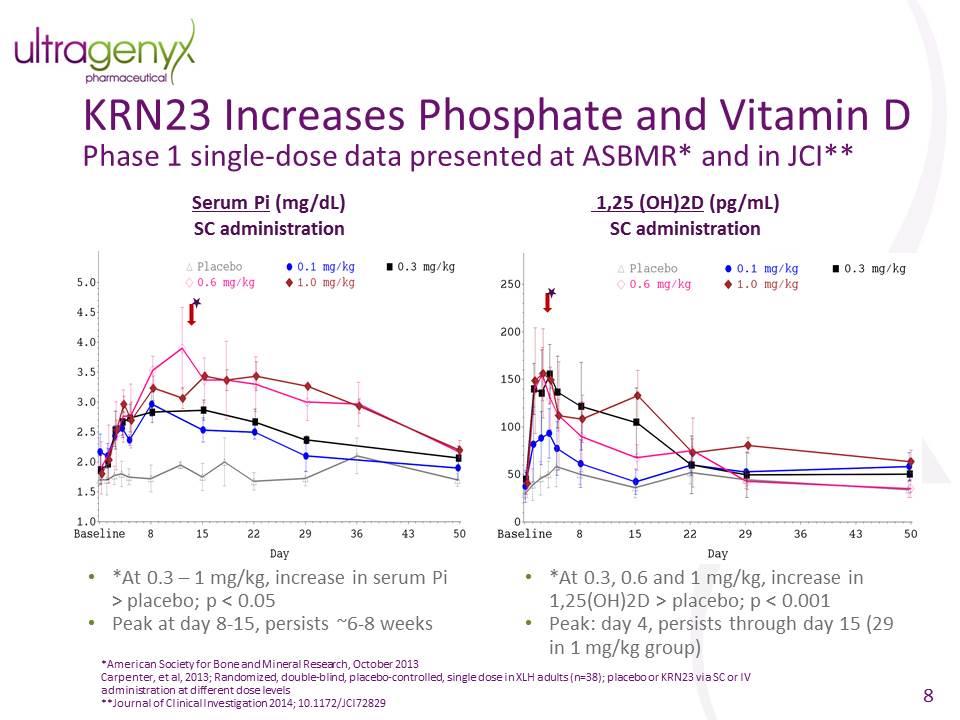
KRN23 Increases Phosphate and Vitamin D Phase 1 single-dose data presented at ASBMR* and in JCI** A *At 0.3 – 1 mg/kg, increase in serum Pi > placebo; p < 0.05 Peak at day 8-15, persists ~6-8 weeks Serum Pi (mg/dL) SC administration 1,25 (OH)2D (pg/mL) SC administration a a *At 0.3, 0.6 and 1 mg/kg, increase in 1,25(OH)2D > placebo; p < 0.001 Peak: day 4, persists through day 15 (29 in 1 mg/kg group) *American Society for Bone and Mineral Research, October 2013 Carpenter, et al, 2013; Randomized, double-blind, placebo-controlled, single dose in XLH adults (n=38); placebo or KRN23 via SC or IV administration at different dose levels **Journal of Clinical Investigation 2014; 10.1172/JCI72829
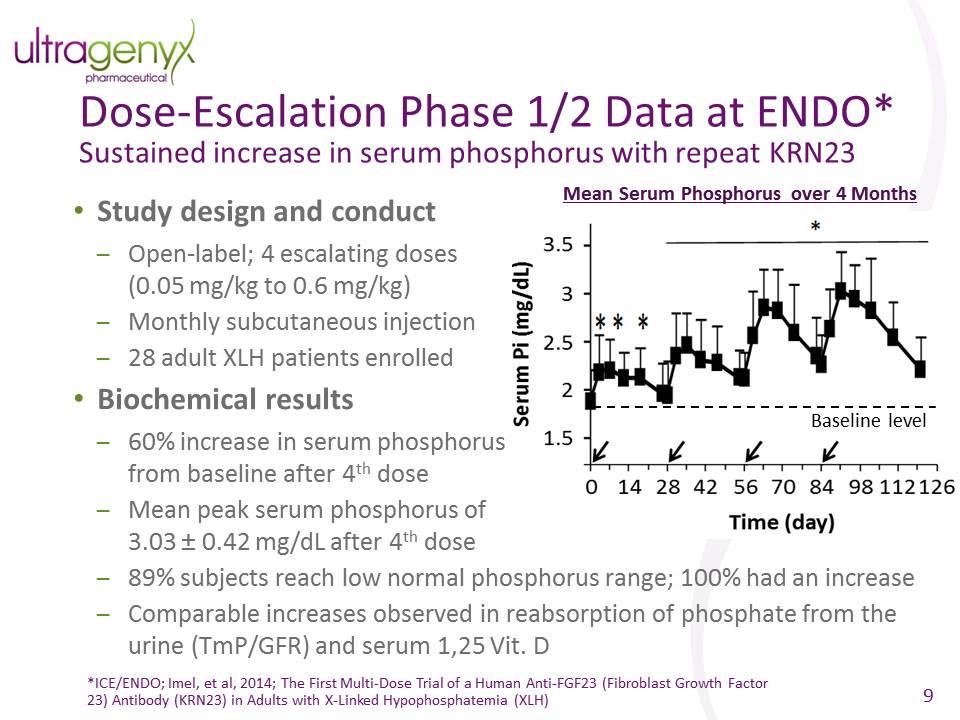
Dose-Escalation Phase 1/2 Data at ENDO* Sustained increase in serum phosphorus with repeat KRN23 *ICE/ENDO; Imel, et al, 2014; The First Multi-Dose Trial of a Human Anti-FGF23 (Fibroblast Growth Factor 23) Antibody (KRN23) in Adults with X-Linked Hypophosphatemia (XLH) Study design and conduct Open-label; 4 escalating doses (0.05 mg/kg to 0.6 mg/kg) Monthly subcutaneous injection 28 adult XLH patients enrolled Biochemical results 60% increase in serum phosphorus from baseline after 4th dose Mean peak serum phosphorus of 3.03 ± 0.42 mg/dL after 4th dose 89% subjects reach low normal phosphorus range; 100% had an increase Comparable increases observed in reabsorption of phosphate from the urine (TmP/GFR) and serum 1,25 Vit. D Mean Serum Phosphorus over 4 Months Baseline level

Increases in bone remodeling markers (P1NP, osteocalcin) support impact of improved phosphate metabolism on bone remodeling Increases in certain QOL measures* in SF-36 & WOMAC physical functioning To be evaluated in future controlled studies Safety No significant changes in parathyroid hormone or calcium or SAEs related to calcification Common AEs: nasopharyngitis, joint pain, diarrhea, back pain, restless legs syndrome One discontinuation due to injection site reaction No anti-KRN23 antibodies observed Data from 12 additional doses to be presented at ASBMR in September 2014 Dose-Escalation Phase 1/2 Data at ENDO Statistically significant increases in bone markers and QOL *SF-36v2 role limitations due to physical health, bodily pain, and physical component summary; WOMAC physical functioning and stiffness Bone Markers P1NP Osteocalcin
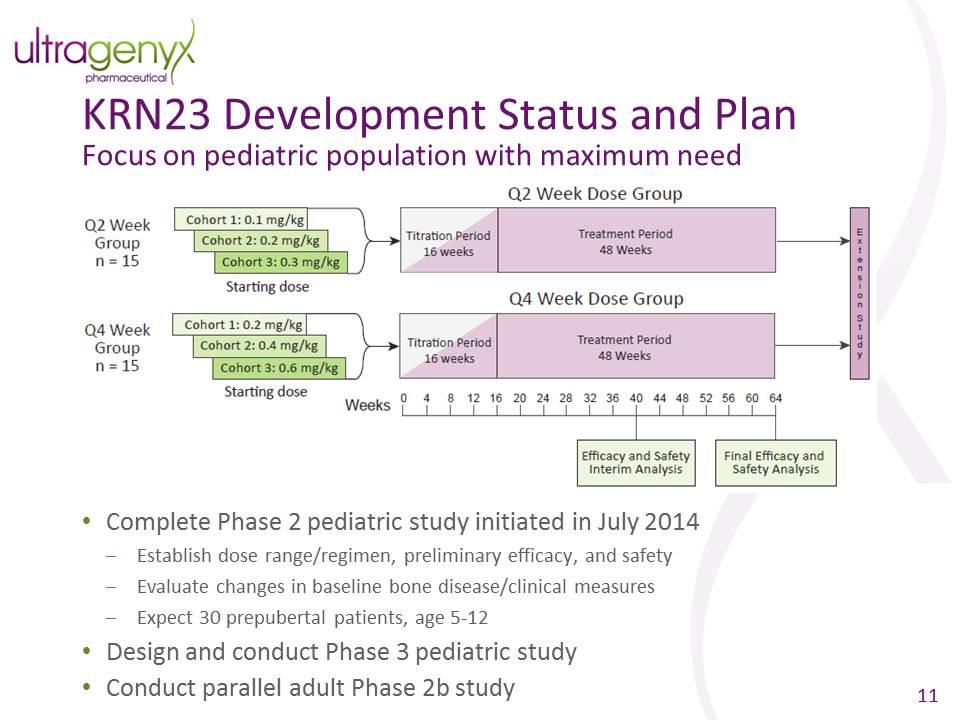
KRN23 Development Status and Plan Focus on pediatric population with maximum need Complete Phase 2 pediatric study initiated in July 2014 Establish dose range/regimen, preliminary efficacy, and safety Evaluate changes in baseline bone disease/clinical measures Expect 30 prepubertal patients, age 5-12 Design and conduct Phase 3 pediatric study Conduct parallel adult Phase 2b study
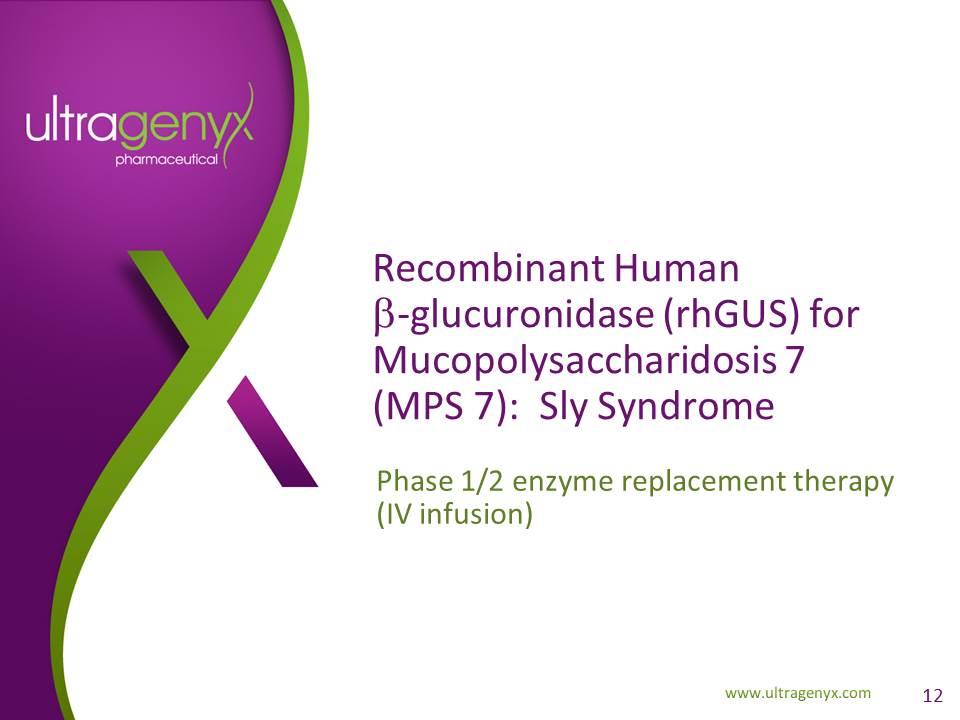
Phase 1/2 enzyme replacement therapy (IV infusion) Recombinant Human b-glucuronidase (rhGUS) for Mucopolysaccharidosis 7 (MPS 7): Sly Syndrome
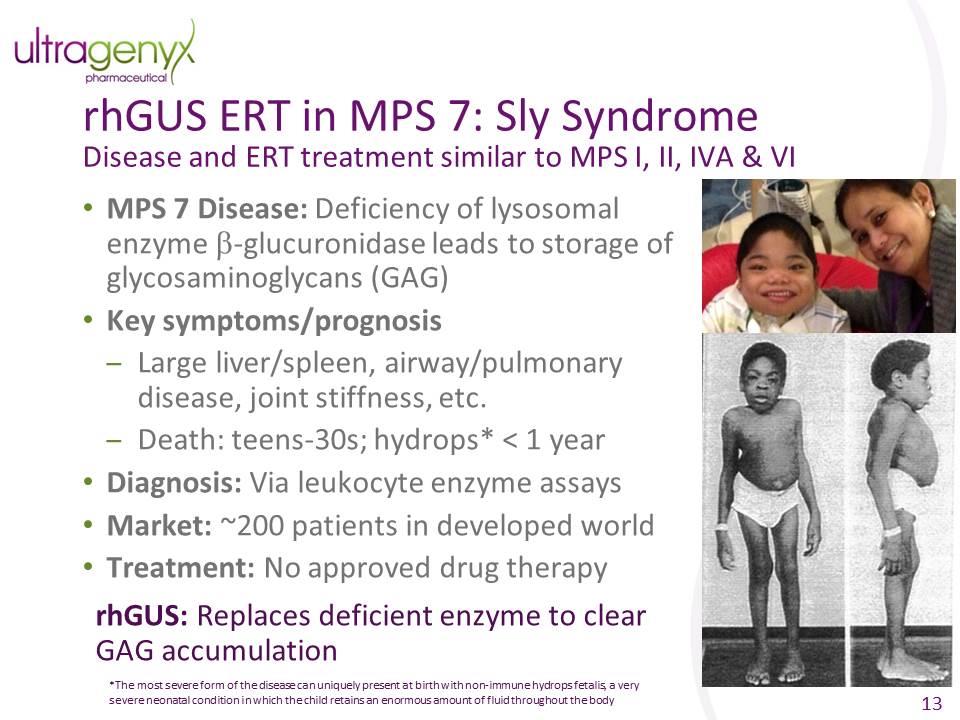
rhGUS ERT in MPS 7: Sly Syndrome Disease and ERT treatment similar to MPS I, II, IVA & VI MPS 7 Disease: Deficiency of lysosomal enzyme b-glucuronidase leads to storage of glycosaminoglycans (GAG) Key symptoms/prognosis Large liver/spleen, airway/pulmonary disease, joint stiffness, etc. Death: teens-30s; hydrops* < 1 year Diagnosis: Via leukocyte enzyme assays Market: ~200 patients in developed world Treatment: No approved drug therapy rhGUS: Replaces deficient enzyme to clear GAG accumulation *The most severe form of the disease can uniquely present at birth with non-immune hydrops fetalis, a very severe neonatal condition in which the child retains an enormous amount of fluid throughout the body
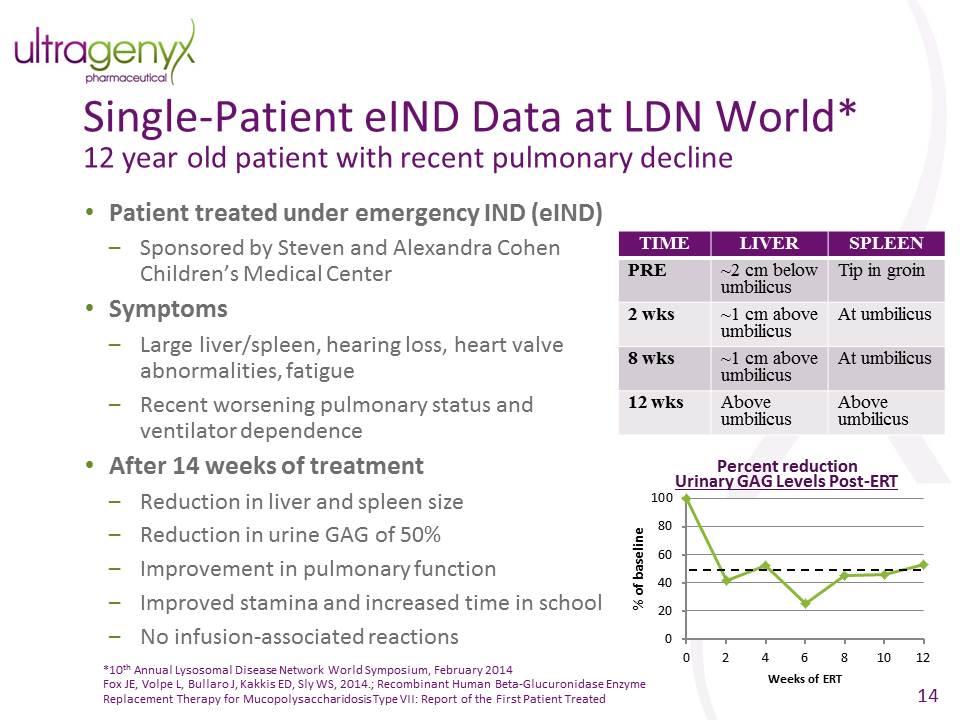
Single-Patient eIND Data at LDN World* 12 year old patient with recent pulmonary decline Patient treated under emergency IND (eIND) Sponsored by Steven and Alexandra Cohen Children’s Medical Center Symptoms Large liver/spleen, hearing loss, heart valve abnormalities, fatigue Recent worsening pulmonary status and ventilator dependence After 14 weeks of treatment Reduction in liver and spleen size Reduction in urine GAG of 50% Improvement in pulmonary function Improved stamina and increased time in school No infusion-associated reactions *10th Annual Lysosomal Disease Network World Symposium, February 2014 Fox JE, Volpe L, Bullaro J, Kakkis ED, Sly WS, 2014.; Recombinant Human Beta-Glucuronidase Enzyme Replacement Therapy for Mucopolysaccharidosis Type VII: Report of the First Patient Treated Urinary GAG Levels Post-ERT TIME Liver Spleen PRE ~2 cm below umbilicus Tip in groin 2 wks ~1 cm above umbilicus At umbilicus 8 wks ~1 cm above umbilicus At umbilicus 12 wks Above umbilicus Above umbilicus
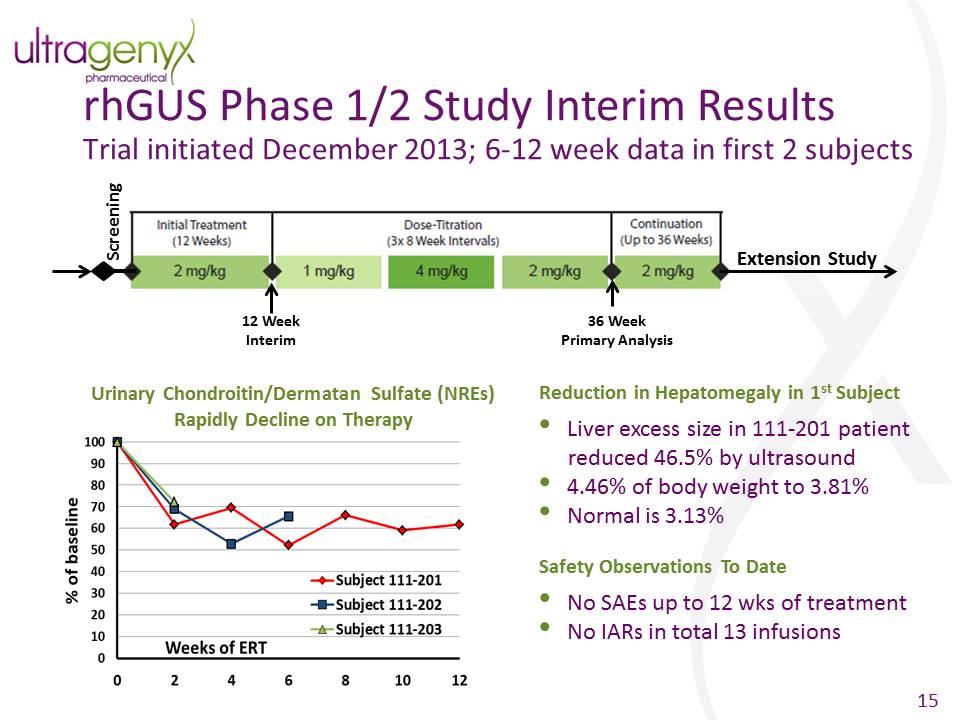
rhGUS Phase 1/2 Study Interim Results Trial initiated December 2013; 6-12 week data in first 2 subjects Extension Study Screening 12 Week Interim 36 Week Primary Analysis Urinary Chondroitin/Dermatan Sulfate (NREs) Rapidly Decline on Therapy No SAEs up to 12 wks of treatment No IARs in total 13 infusions Safety Observations To Date Liver excess size in 111-201 patient reduced 46.5% by ultrasound 4.46% of body weight to 3.81% Normal is 3.13% Reduction in Hepatomegaly in 1st Subject
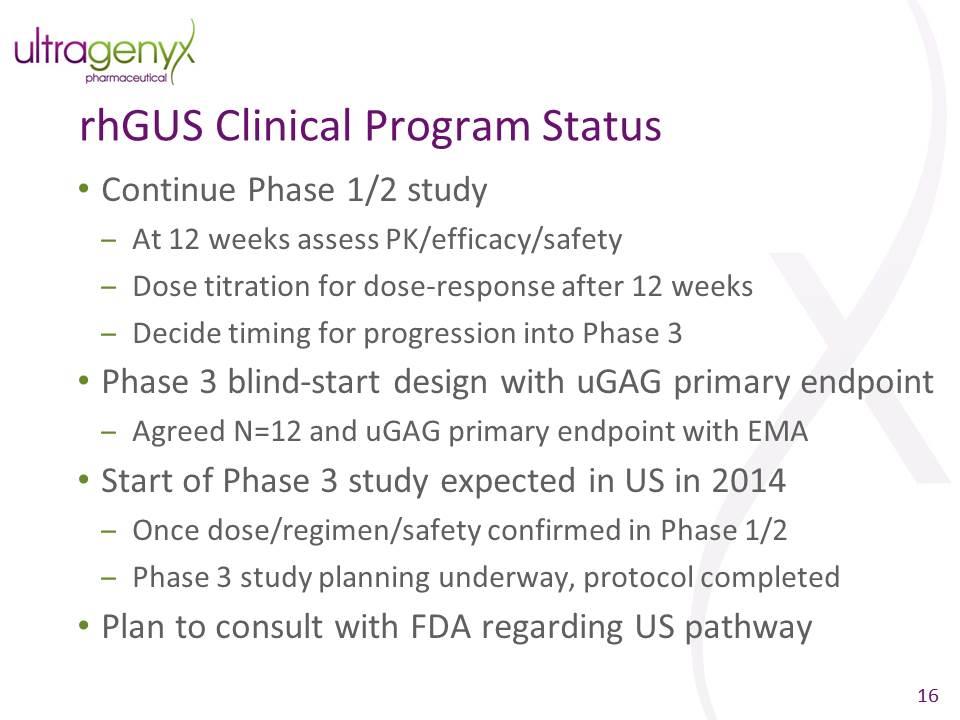
rhGUS Clinical Program Status Continue Phase 1/2 study At 12 weeks assess PK/efficacy/safety Dose titration for dose-response after 12 weeks Decide timing for progression into Phase 3 Phase 3 blind-start design with uGAG primary endpoint Agreed N=12 and uGAG primary endpoint with EMA Start of Phase 3 study expected in US in 2014 Once dose/regimen/safety confirmed in Phase 1/2 Phase 3 study planning underway, protocol completed Plan to consult with FDA regarding US pathway
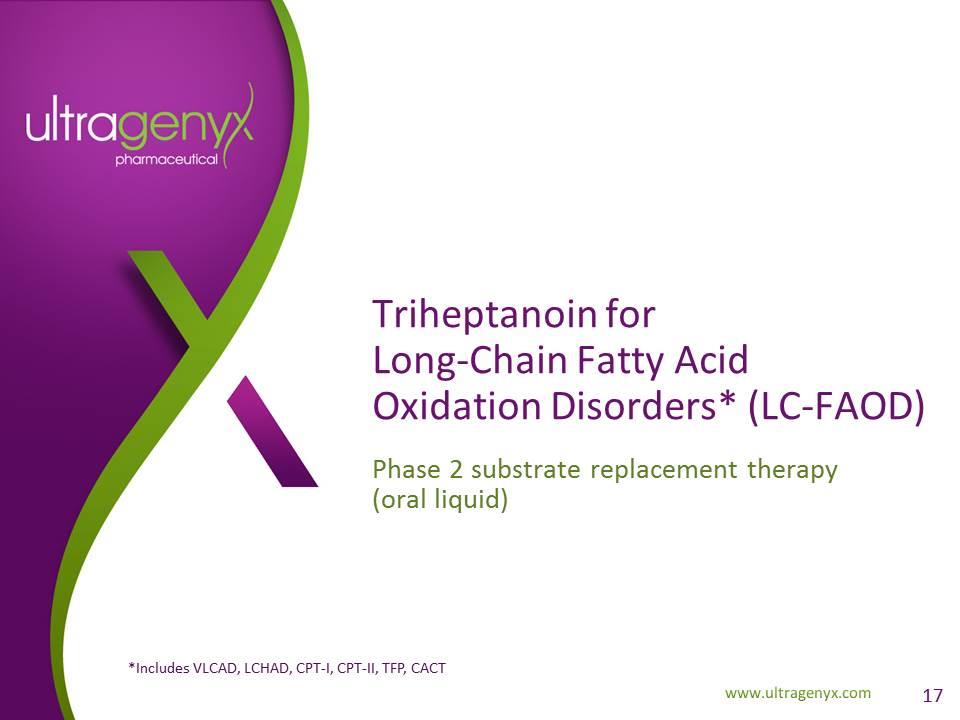
Phase 2 substrate replacement therapy (oral liquid) Triheptanoin for Long-Chain Fatty Acid Oxidation Disorders* (LC-FAOD) *Includes VLCAD, LCHAD, CPT-I, CPT-II, TFP, CACT
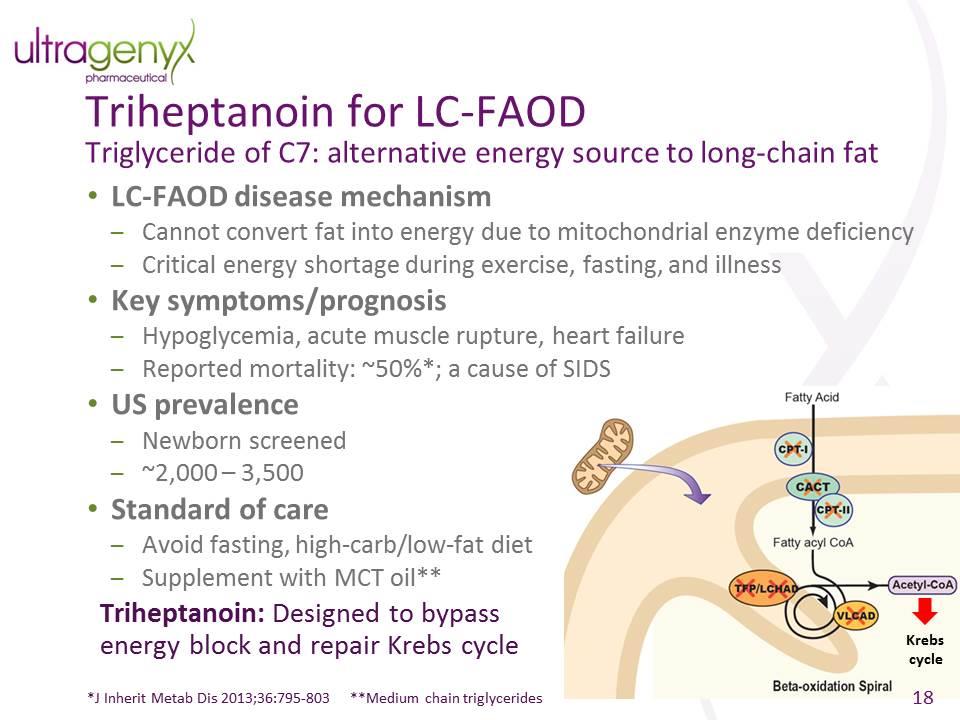
Triheptanoin for LC-FAOD Triglyceride of C7: alternative energy source to long-chain fat LC-FAOD disease mechanism Cannot convert fat into energy due to mitochondrial enzyme deficiency Critical energy shortage during exercise, fasting, and illness Key symptoms/prognosis Hypoglycemia, acute muscle rupture, heart failure Reported mortality: ~50%*; a cause of SIDS US prevalence Newborn screened ~2,000 – 3,500 Standard of care Avoid fasting, high-carb/low-fat diet Supplement with MCT oil** Triheptanoin: Designed to bypass energy block and repair Krebs cycle Krebs cycle *J Inherit Metab Dis 2013;36:795-803 **Medium chain triglycerides
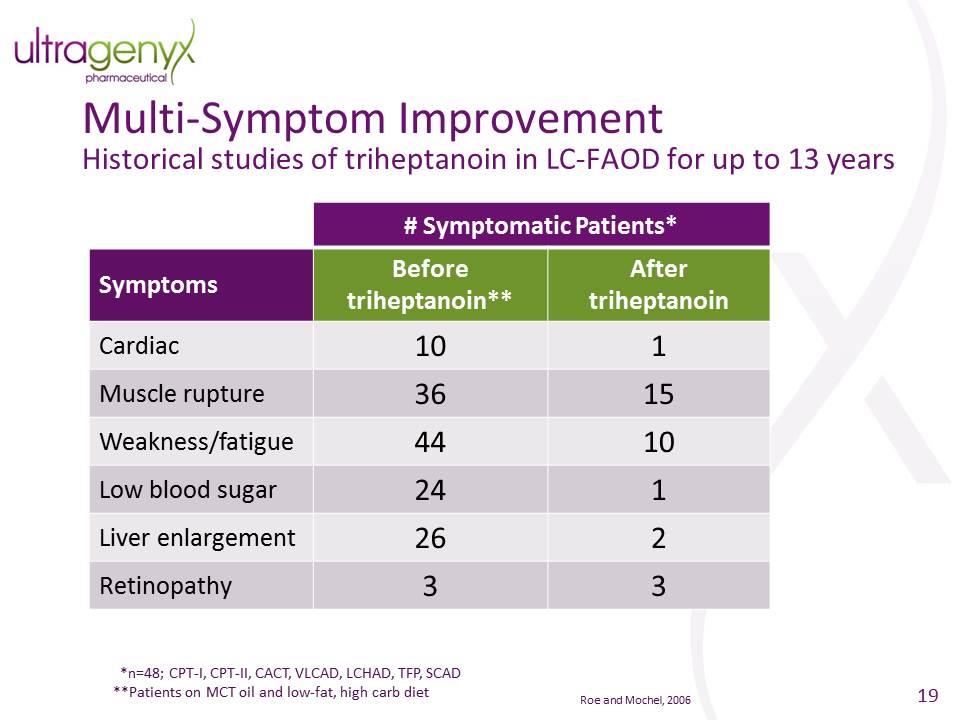
Multi-Symptom Improvement Historical studies of triheptanoin in LC-FAOD for up to 13 years # Symptomatic Patients* Symptoms Before triheptanoin** After triheptanoin Cardiac 10 1 Muscle rupture 36 15 Weakness/fatigue 44 10 Low blood sugar 24 1 Liver enlargement 26 2 Retinopathy 3 3 *n=48; CPT-I, CPT-II, CACT, VLCAD, LCHAD, TFP, SCAD **Patients on MCT oil and low-fat, high carb diet Roe and Mochel, 2006
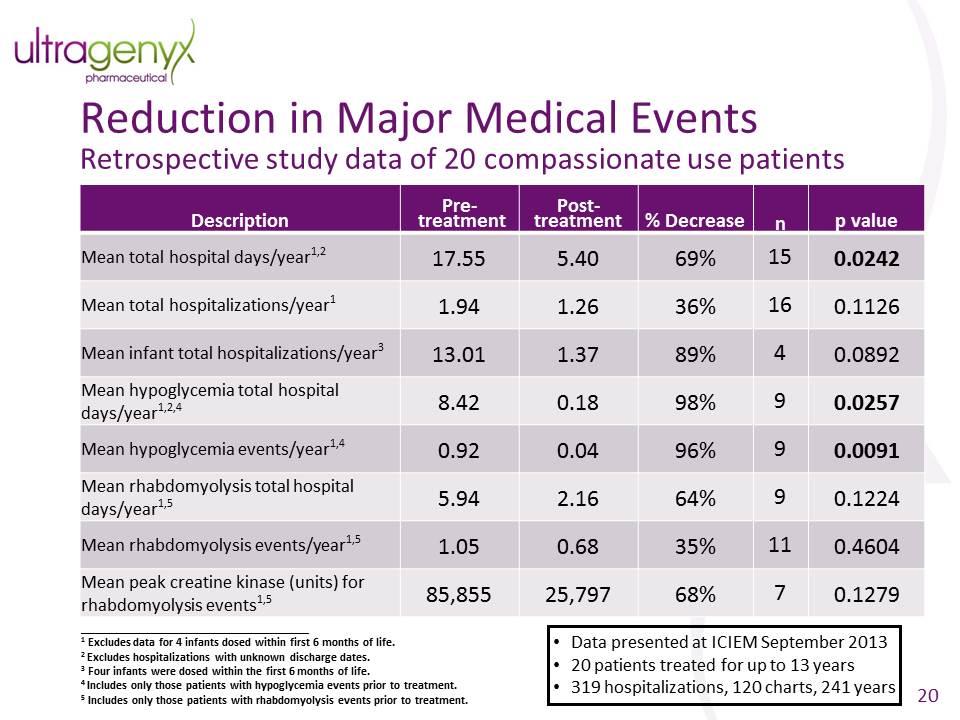
______________________________________ 1 Excludes data for 4 infants dosed within first 6 months of life. 2 Excludes hospitalizations with unknown discharge dates. 3 Four infants were dosed within the first 6 months of life. 4 Includes only those patients with hypoglycemia events prior to treatment. 5 Includes only those patients with rhabdomyolysis events prior to treatment. Description Pre- treatment Post- treatment % Decrease n p value Mean total hospital days/year1,2 17.55 5.40 69% 15 0.0242 Mean total hospitalizations/year1 1.94 1.26 36% 16 0.1126 Mean infant total hospitalizations/year3 13.01 1.37 89% 4 0.0892 Mean hypoglycemia total hospital days/year1,2,4 8.42 0.18 98% 9 0.0257 Mean hypoglycemia events/year1,4 0.92 0.04 96% 9 0.0091 Mean rhabdomyolysis total hospital days/year1,5 5.94 2.16 64% 9 0.1224 Mean rhabdomyolysis events/year1,5 1.05 0.68 35% 11 0.4604 Mean peak creatine kinase (units) for rhabdomyolysis events1,5 85,855 25,797 68% 7 0.1279 Data presented at ICIEM September 2013 20 patients treated for up to 13 years 319 hospitalizations, 120 charts, 241 years Reduction in Major Medical Events Retrospective study data of 20 compassionate use patients
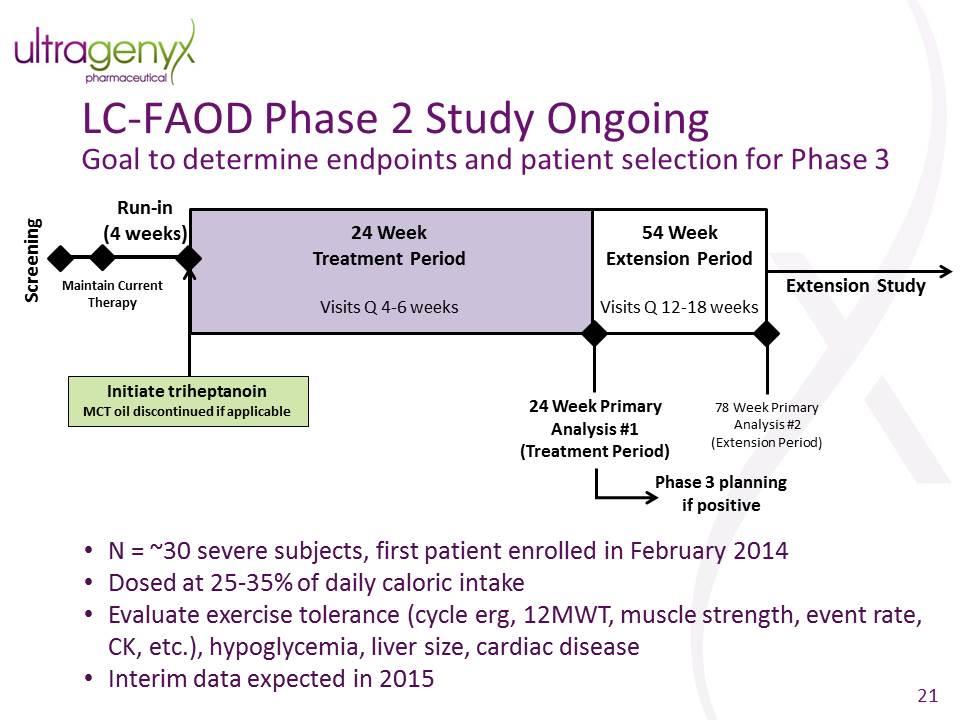
Maintain Current Therapy LC-FAOD Phase 2 Study Ongoing Goal to determine endpoints and patient selection for Phase 3 N = ~30 severe subjects, first patient enrolled in February 2014 Dosed at 25-35% of daily caloric intake Evaluate exercise tolerance (cycle erg, 12MWT, muscle strength, event rate, CK, etc.), hypoglycemia, liver size, cardiac disease Interim data expected in 2015 Screening Run-in (4 weeks) 24 Week Treatment Period Visits Q 4-6 weeks Extension Study 54 Week Extension Period Visits Q 12-18 weeks 24 Week Primary Analysis #1 (Treatment Period) 78 Week Primary Analysis #2 (Extension Period) Initiate triheptanoin MCT oil discontinued if applicable Phase 3 planning if positive
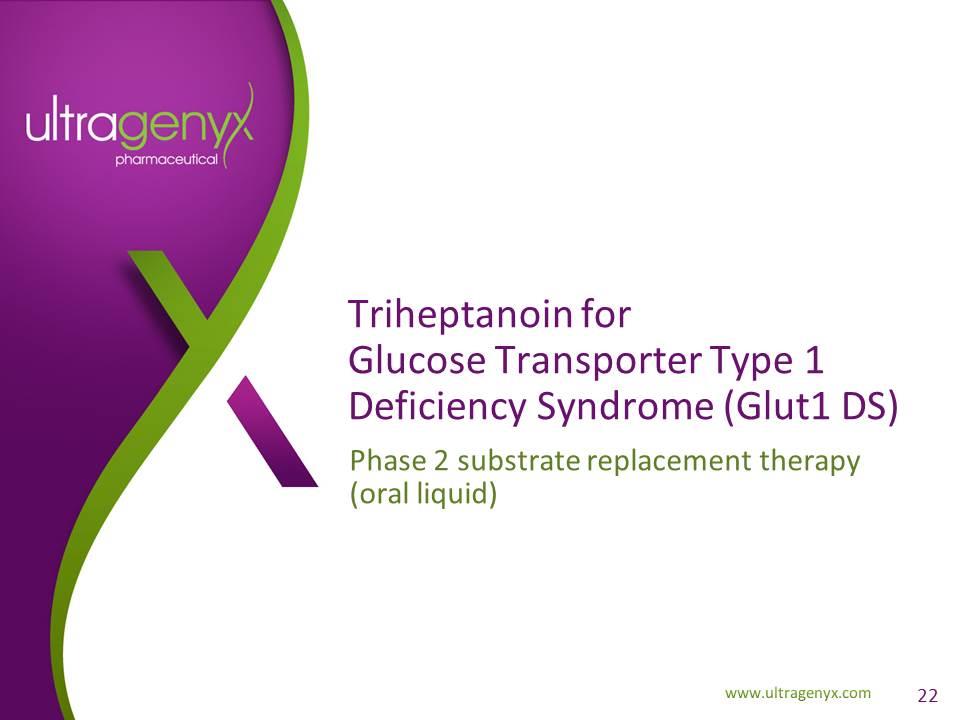
Phase 2 substrate replacement therapy (oral liquid) Triheptanoin for Glucose Transporter Type 1 Deficiency Syndrome (Glut1 DS)
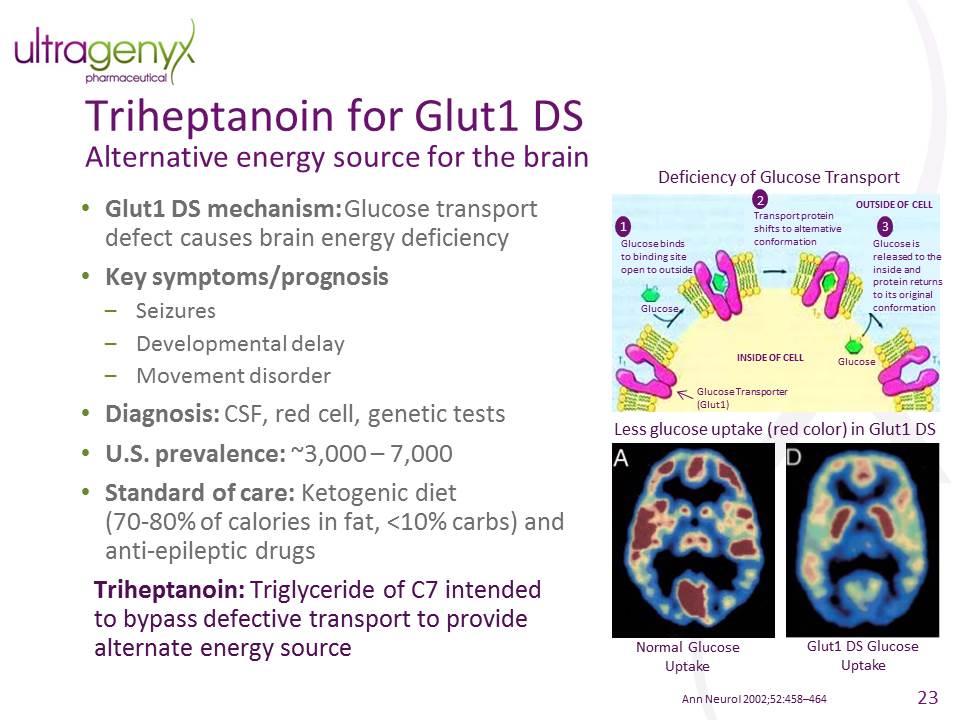
Glut1 DS mechanism: Glucose transport defect causes brain energy deficiency Key symptoms/prognosis Seizures Developmental delay Movement disorder Diagnosis: CSF, red cell, genetic tests U.S. prevalence: ~3,000 – 7,000 Standard of care: Ketogenic diet (70-80% of calories in fat, <10% carbs) and anti-epileptic drugs Triheptanoin: Triglyceride of C7 intended to bypass defective transport to provide alternate energy source Triheptanoin for Glut1 DS Alternative energy source for the brain Ann Neurol 2002;52:458–464 Normal Glucose Uptake Glut1 DS Glucose Uptake Less glucose uptake (red color) in Glut1 DS Glucose Transporter (Glut1) INSIDE OF CELL Glucose Glucose binds to binding site open to outside Transport protein shifts to alternative conformation Glucose is released to the inside and protein returns to its original conformation 1 2 3 OUTSIDE OF CELL Glucose Deficiency of Glucose Transport
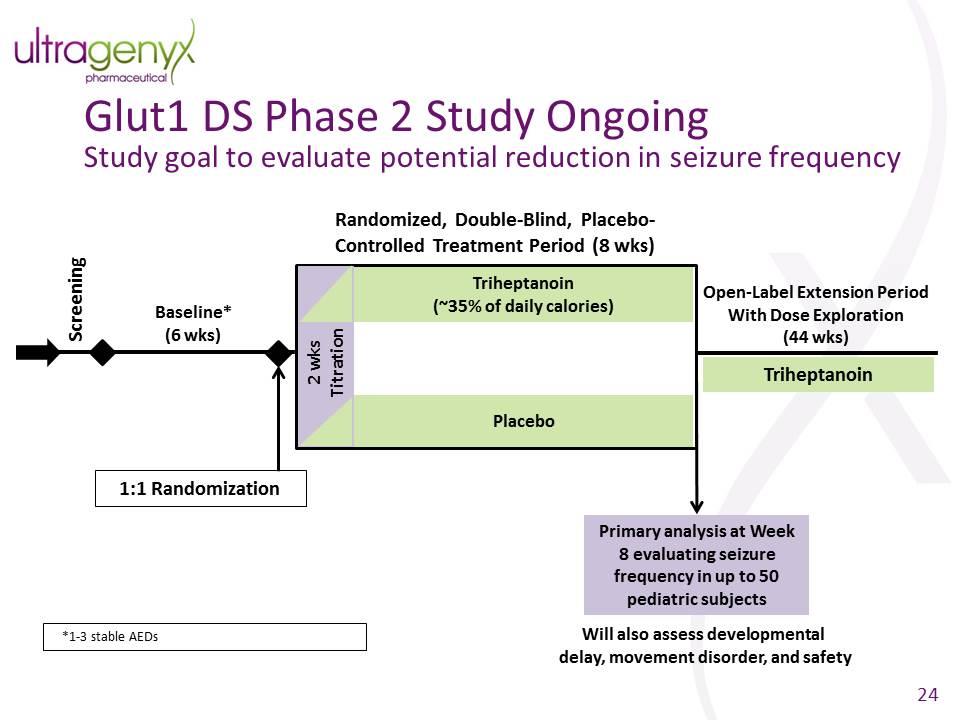
Glut1 DS Phase 2 Study Ongoing Study goal to evaluate potential reduction in seizure frequency Screening Baseline* (6 wks) 1:1 Randomization Randomized, Double-Blind, Placebo-Controlled Treatment Period (8 wks) Placebo Primary analysis at Week 8 evaluating seizure frequency in up to 50 pediatric subjects Open-Label Extension Period With Dose Exploration (44 wks) Triheptanoin *1-3 stable AEDs Triheptanoin (~35% of daily calories) Will also assess developmental delay, movement disorder, and safety 2 wks Titration
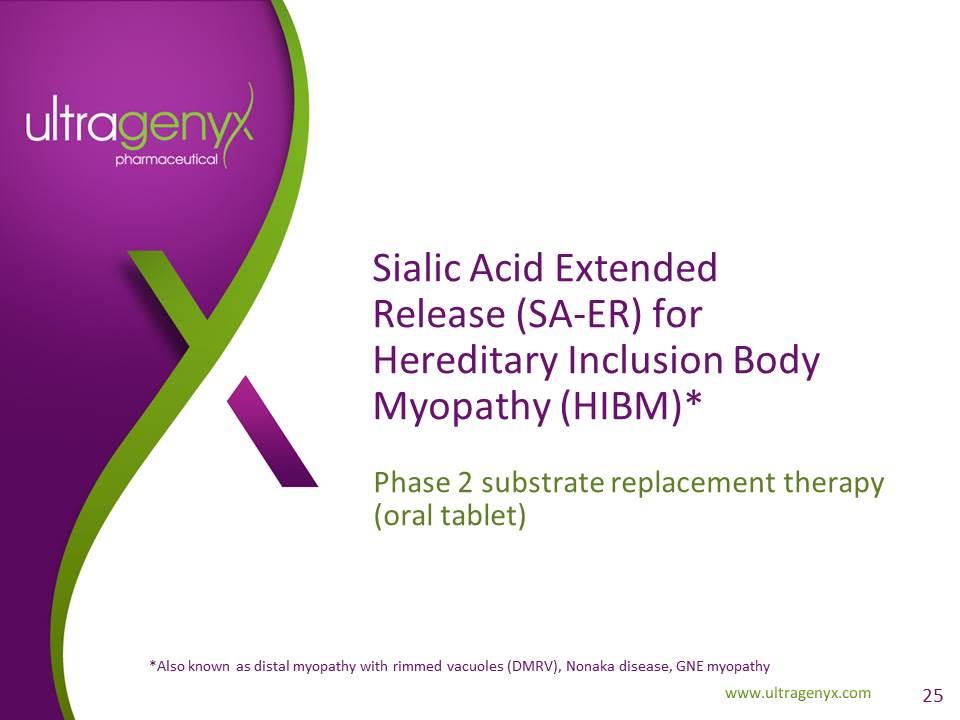
Phase 2 substrate replacement therapy (oral tablet) Sialic Acid Extended Release (SA-ER) for Hereditary Inclusion Body Myopathy (HIBM)* *Also known as distal myopathy with rimmed vacuoles (DMRV), Nonaka disease, GNE myopathy
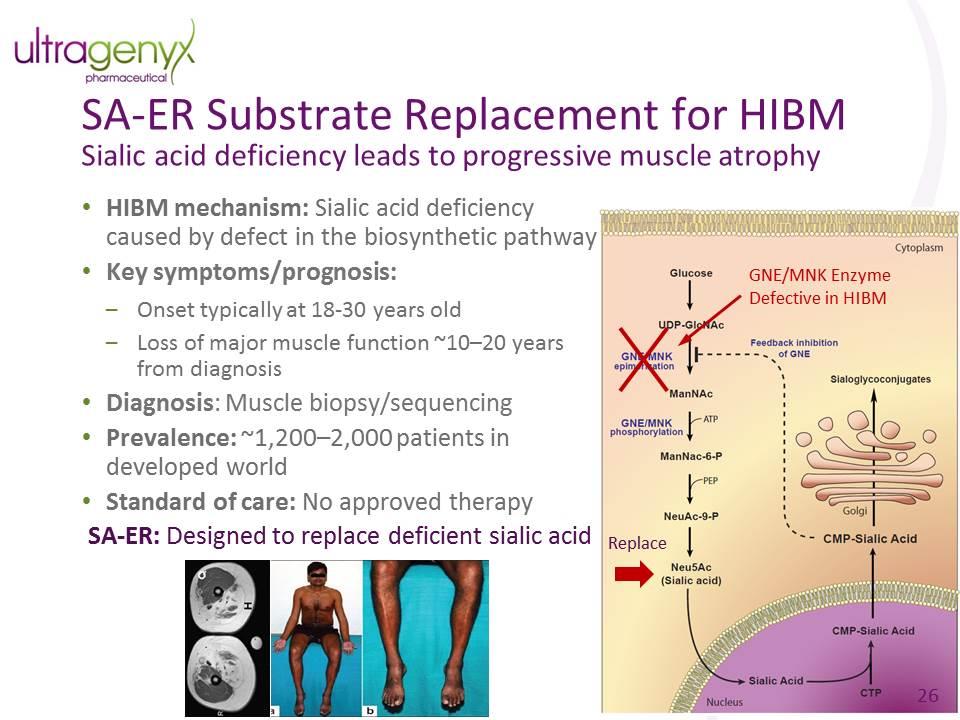
GNE/MNK Enzyme Defective in HIBM SA-ER Substrate Replacement for HIBM Sialic acid deficiency leads to progressive muscle atrophy HIBM mechanism: Sialic acid deficiency caused by defect in the biosynthetic pathway Key symptoms/prognosis: Onset typically at 18-30 years old Loss of major muscle function ~10–20 years from diagnosis Diagnosis: Muscle biopsy/sequencing Prevalence: ~1,200–2,000 patients in developed world Standard of care: No approved therapy SA-ER: Designed to replace deficient sialic acid Replace
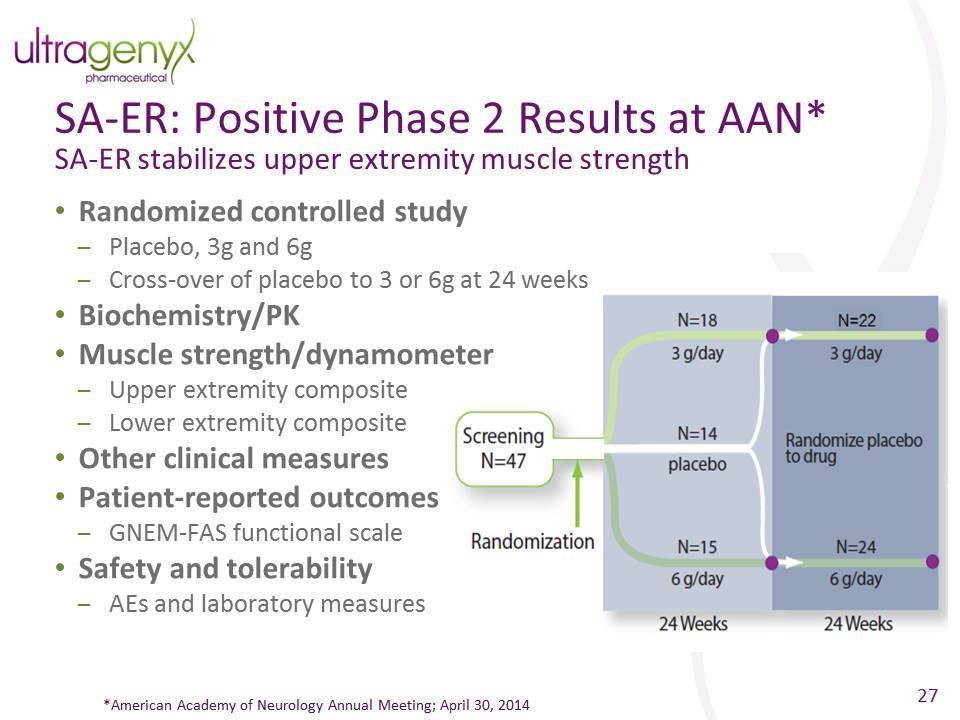
Randomized controlled study Placebo, 3g and 6g Cross-over of placebo to 3 or 6g at 24 weeks Biochemistry/PK Muscle strength/dynamometer Upper extremity composite Lower extremity composite Other clinical measures Patient-reported outcomes GNEM-FAS functional scale Safety and tolerability AEs and laboratory measures SA-ER: Positive Phase 2 Results at AAN* SA-ER stabilizes upper extremity muscle strength *American Academy of Neurology Annual Meeting; April 30, 2014
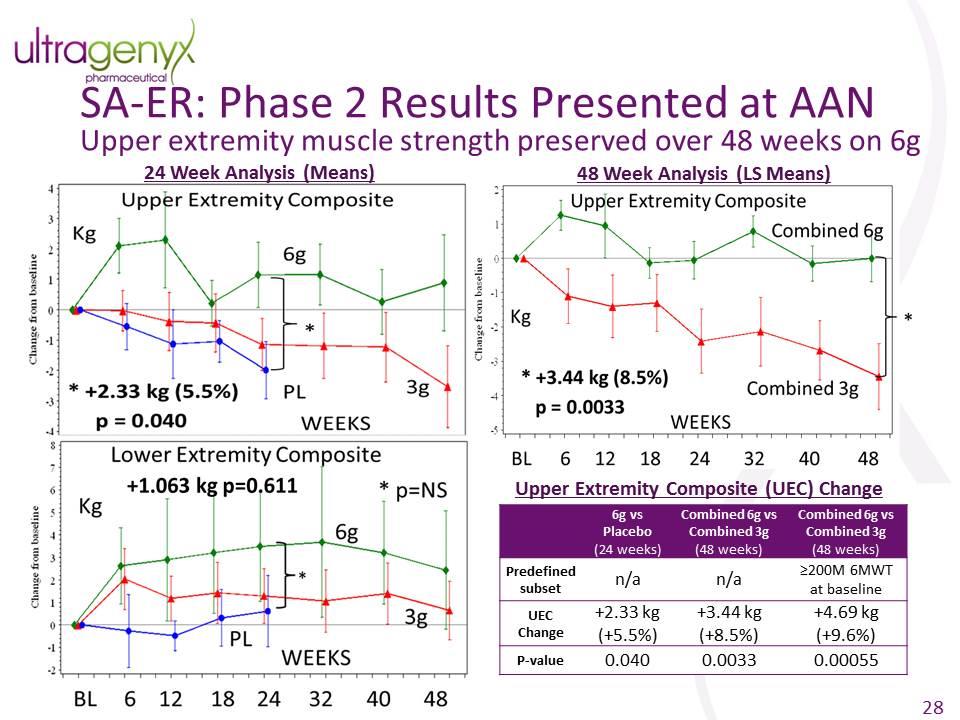
SA-ER: Phase 2 Results Presented at AAN Upper extremity muscle strength preserved over 48 weeks on 6g 48 Week Analysis (LS Means) 6g vs Placebo (24 weeks) Combined 6g vs Combined 3g (48 weeks) Combined 6g vs Combined 3g (48 weeks) Predefined subset n/a n/a ≥200M 6MWT at baseline UEC Change +2.33 kg (+5.5%) +3.44 kg (+8.5%) +4.69 kg (+9.6%) P-value 0.040 0.0033 0.00055 Upper Extremity Composite (UEC) Change 24 Week Analysis (Means)
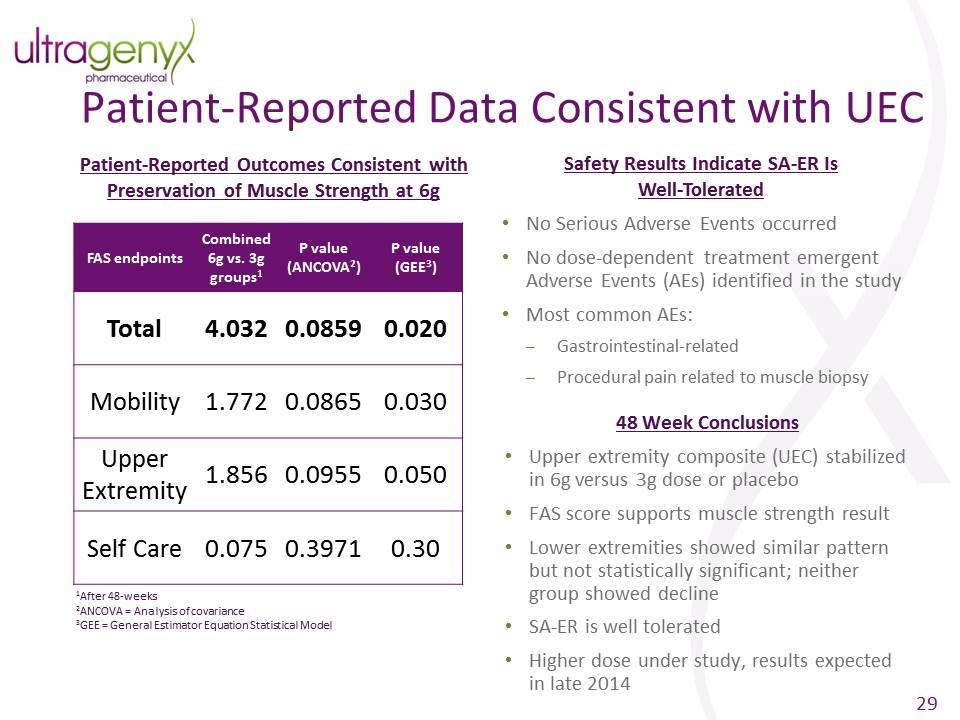
Patient-Reported Outcomes Consistent with Preservation of Muscle Strength at 6g Safety Results Indicate SA-ER Is Well-Tolerated No Serious Adverse Events occurred No dose-dependent treatment emergent Adverse Events (AEs) identified in the study Most common AEs: Gastrointestinal-related Procedural pain related to muscle biopsy 1After 48-weeks 2ANCOVA = Analysis of covariance 3GEE = General Estimator Equation Statistical Model FAS endpoints Combined 6g vs. 3g groups1 P value (ANCOVA2) P value (GEE3) Total 4.032 0.0859 0.020 Mobility 1.772 0.0865 0.030 Upper Extremity 1.856 0.0955 0.050 Self Care 0.075 0.3971 0.30 Patient-Reported Data Consistent with UEC 48 Week Conclusions Upper extremity composite (UEC) stabilized in 6g versus 3g dose or placebo FAS score supports muscle strength result Lower extremities showed similar pattern but not statistically significant; neither group showed decline SA-ER is well tolerated Higher dose under study, results expected in late 2014
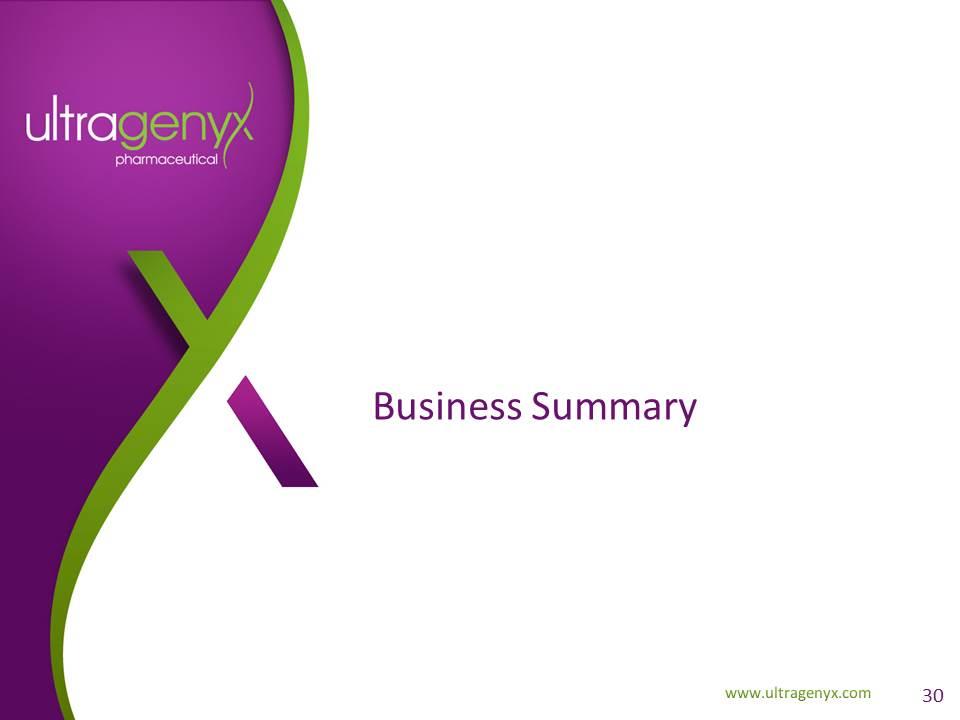
Business Summary
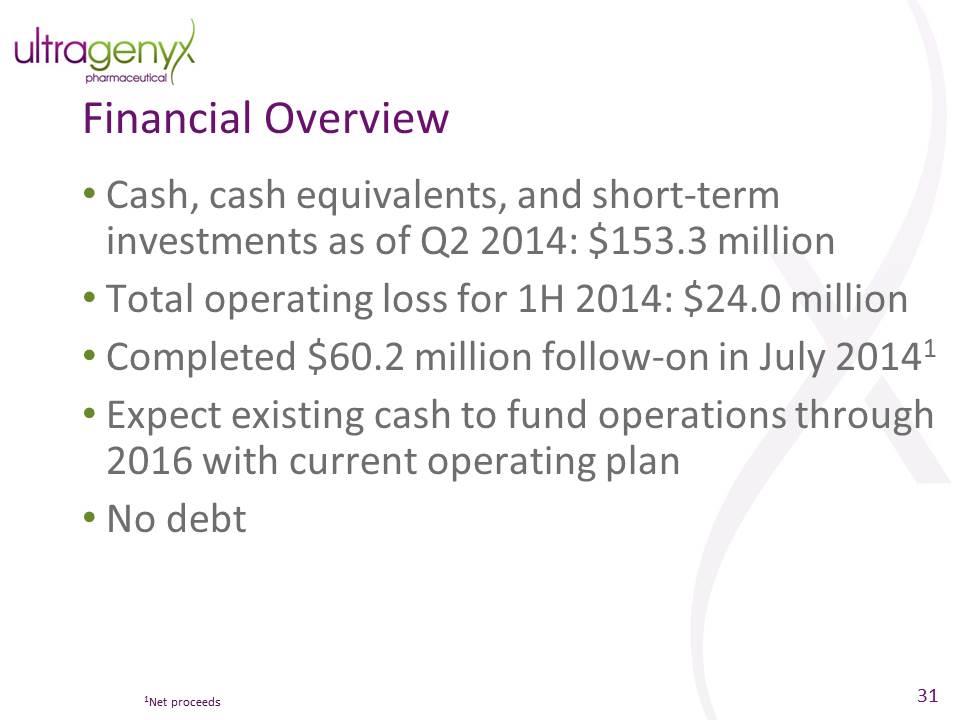
Financial Overview Cash, cash equivalents, and short-term investments as of Q2 2014: $153.3 million Total operating loss for 1H 2014: $24.0 million Completed $60.2 million follow-on in July 20141 Expect existing cash to fund operations through 2016 with current operating plan No debt 1Net proceeds
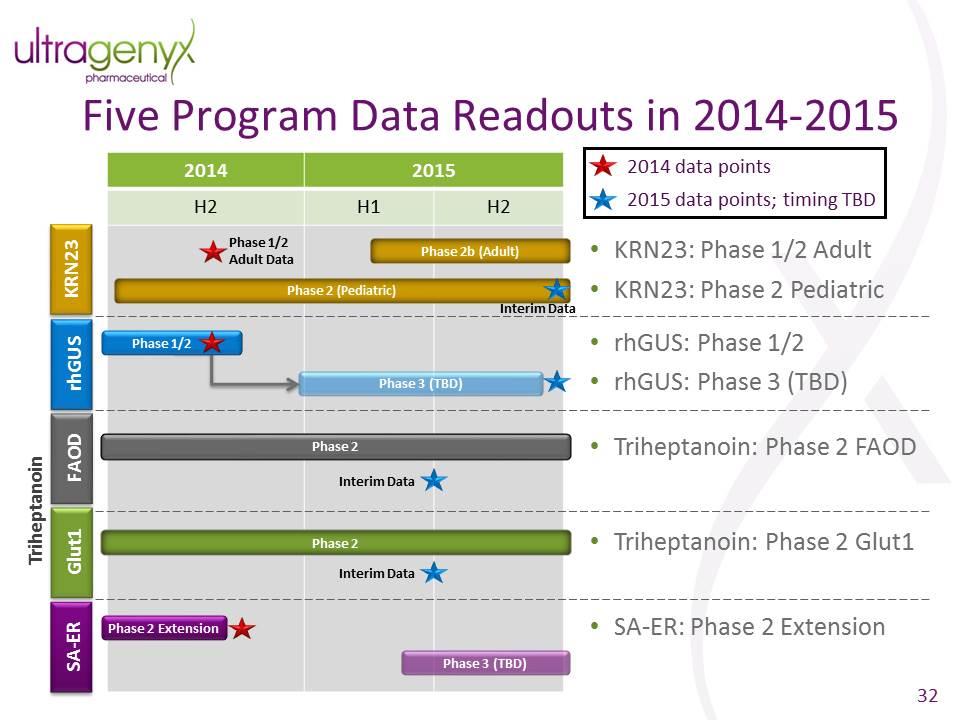
2014 2015 H2 H1 H2 SA-ER rhGUS FAOD Glut1 Phase 1/2 KRN23 Phase 2 (Pediatric) Phase 2 Extension Phase 3 (TBD) Triheptanoin 2014 data points 2015 data points; timing TBD KRN23: Phase 1/2 Adult KRN23: Phase 2 Pediatric rhGUS: Phase 1/2 rhGUS: Phase 3 (TBD) Triheptanoin: Phase 2 FAOD Triheptanoin: Phase 2 Glut1 SA-ER: Phase 2 Extension Five Program Data Readouts in 2014-2015 Phase 2 Phase 1/2 Adult Data Phase 2b (Adult) Phase 3 (TBD) Interim Data Interim Data Phase 2 Interim Data
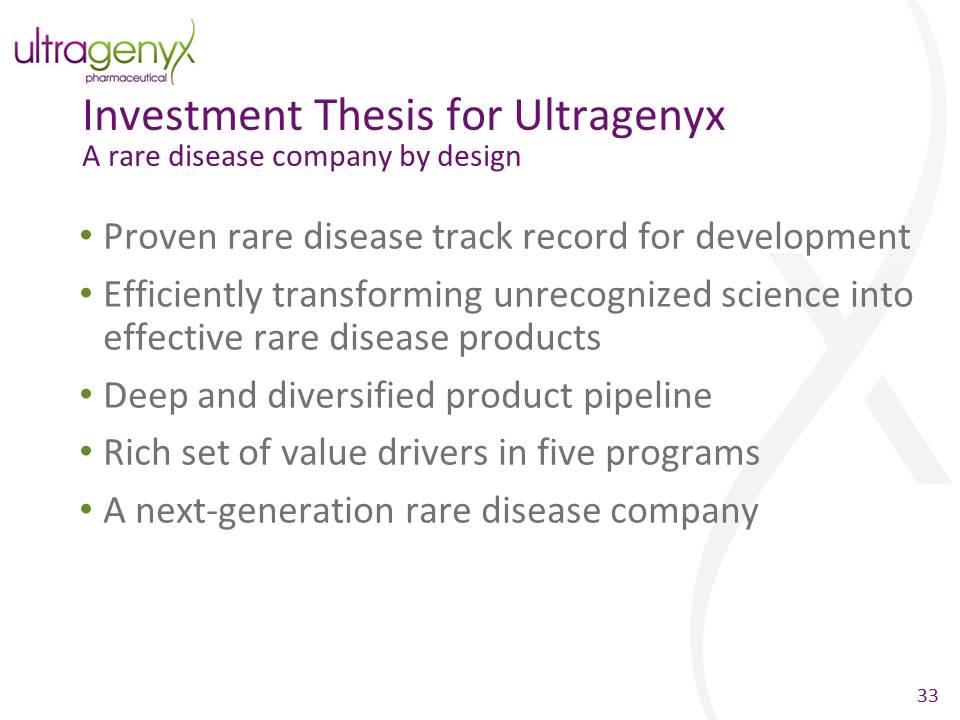
Investment Thesis for Ultragenyx A rare disease company by design Proven rare disease track record for development Efficiently transforming unrecognized science into effective rare disease products Deep and diversified product pipeline Rich set of value drivers in five programs A next-generation rare disease company
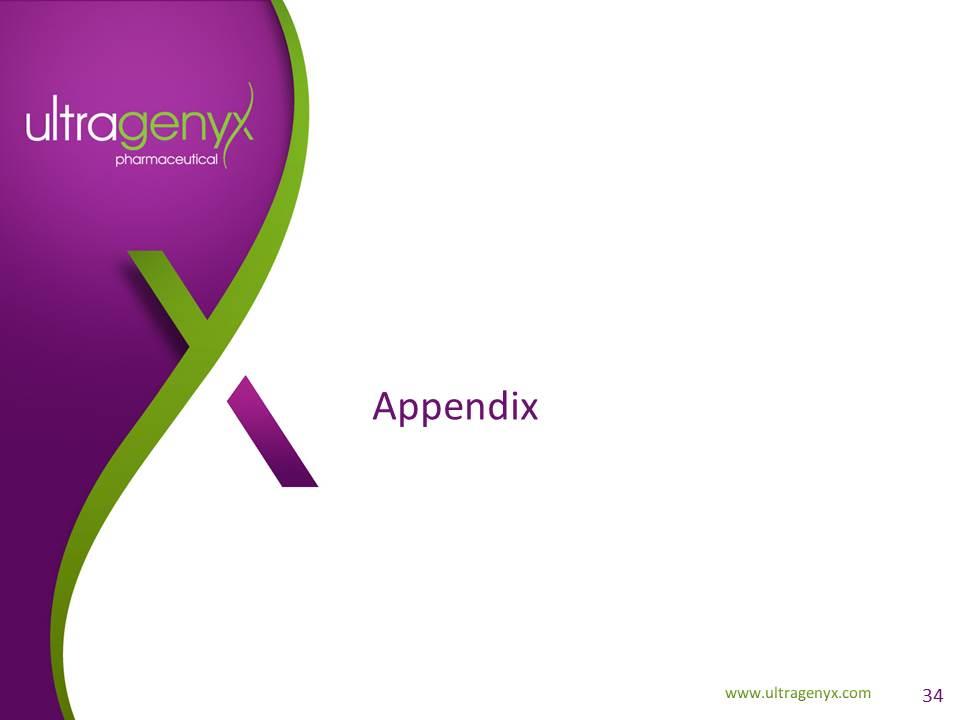
Appendix
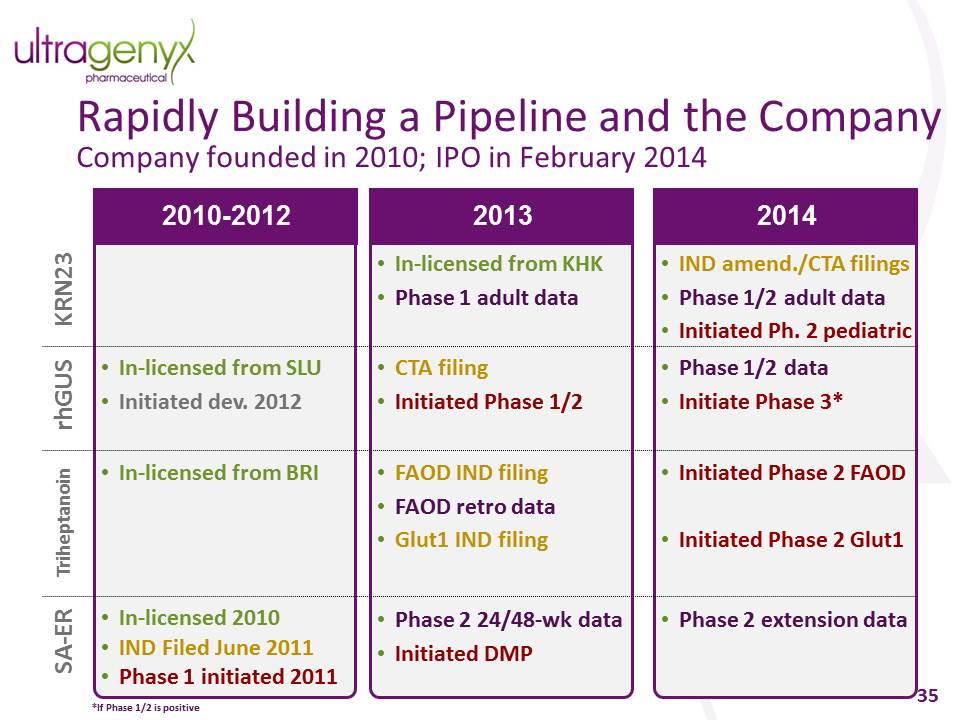
Rapidly Building a Pipeline and the Company Company founded in 2010; IPO in February 2014 2013 2014 In-licensed from KHK Phase 1 adult data KRN23 rhGUS Triheptanoin SA-ER CTA filing Initiated Phase 1/2 FAOD IND filing FAOD retro data Glut1 IND filing Phase 2 24/48-wk data Initiated DMP IND amend./CTA filings Phase 1/2 adult data Initiated Ph. 2 pediatric Phase 1/2 data Initiate Phase 3* Initiated Phase 2 FAOD Initiated Phase 2 Glut1 Phase 2 extension data *If Phase 1/2 is positive 2010-2012 In-licensed from SLU Initiated dev. 2012 In-licensed 2010 IND Filed June 2011 Phase 1 initiated 2011 In-licensed from BRI
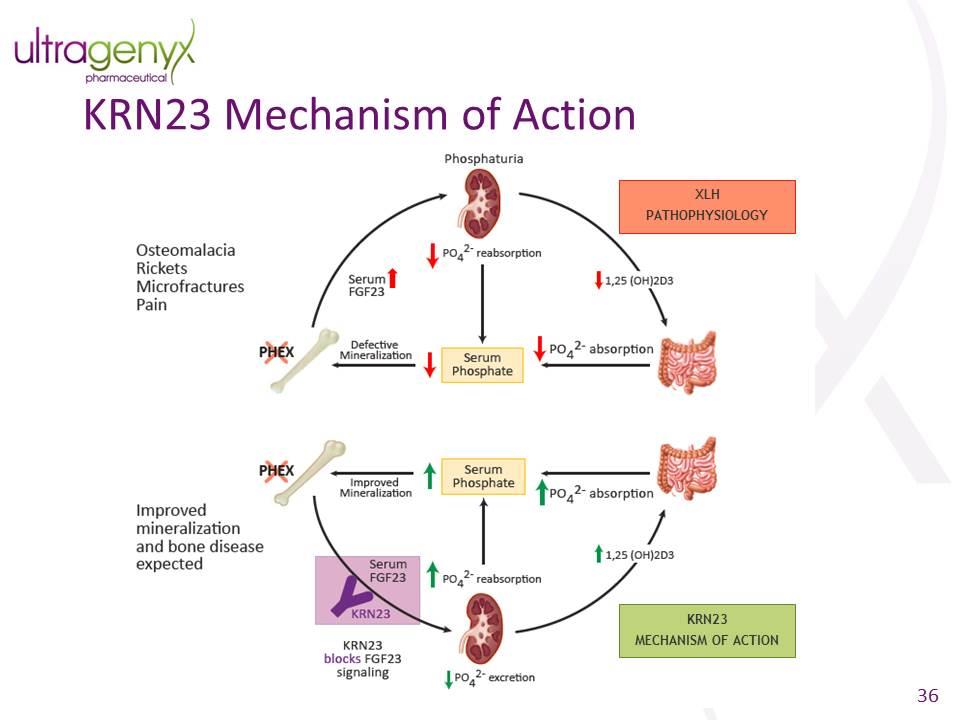
KRN23 Mechanism of Action XLH PATHOPHYSIOLOGY KRN23 MECHANISM OF ACTION
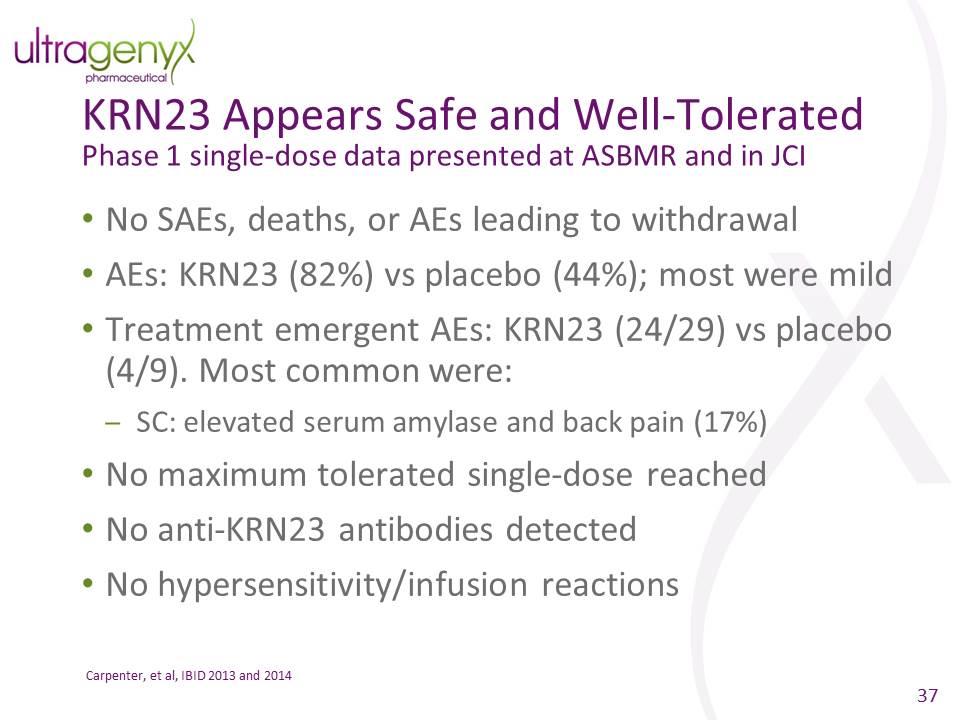
KRN23 Appears Safe and Well-Tolerated Phase 1 single-dose data presented at ASBMR and in JCI Carpenter, et al, IBID 2013 and 2014 No SAEs, deaths, or AEs leading to withdrawal AEs: KRN23 (82%) vs placebo (44%); most were mild Treatment emergent AEs: KRN23 (24/29) vs placebo (4/9). Most common were: SC: elevated serum amylase and back pain (17%) No maximum tolerated single-dose reached No anti-KRN23 antibodies detected No hypersensitivity/infusion reactions
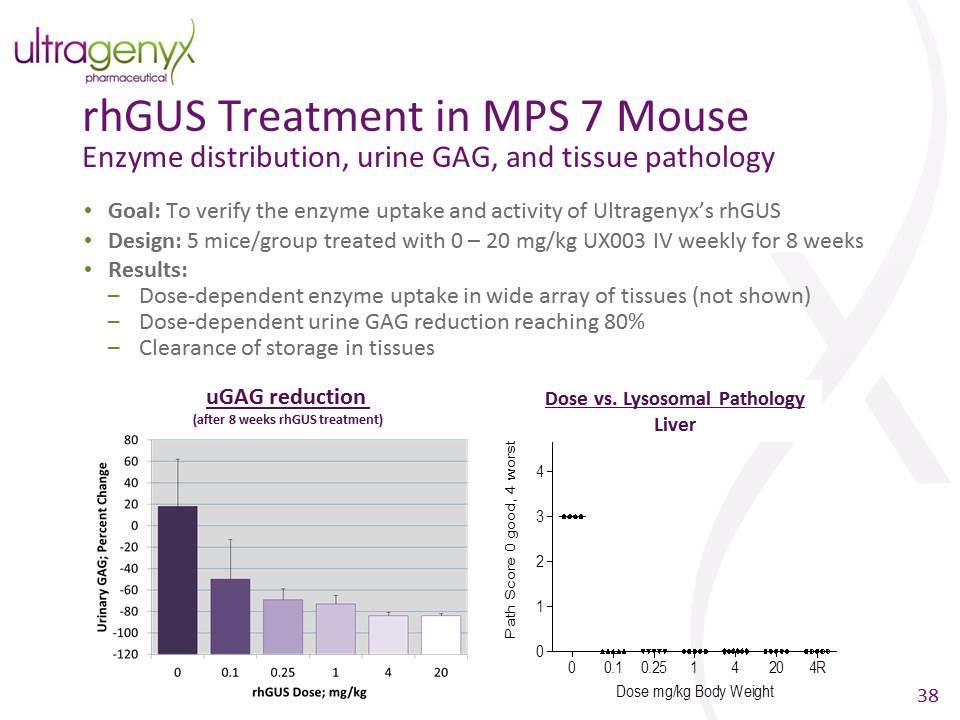
rhGUS Treatment in MPS 7 Mouse Enzyme distribution, urine GAG, and tissue pathology Goal: To verify the enzyme uptake and activity of Ultragenyx’s rhGUS Design: 5 mice/group treated with 0 – 20 mg/kg UX003 IV weekly for 8 weeks Results: Dose-dependent enzyme uptake in wide array of tissues (not shown) Dose-dependent urine GAG reduction reaching 80% Clearance of storage in tissues Dose vs. Lysosomal Pathology Liver uGAG reduction (after 8 weeks rhGUS treatment)
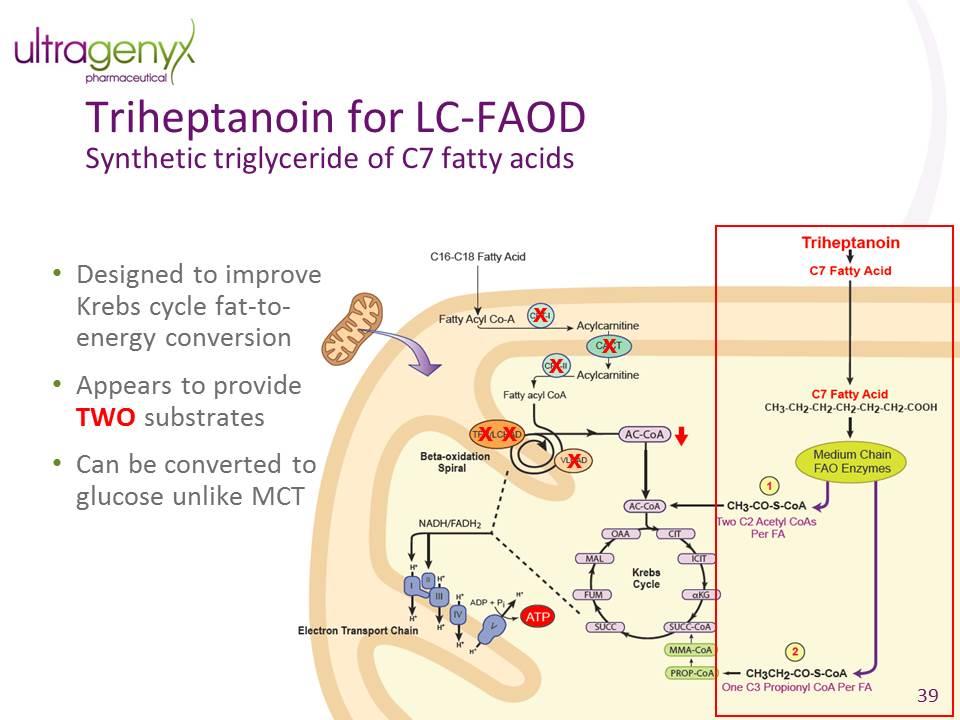
Triheptanoin for LC-FAOD Synthetic triglyceride of C7 fatty acids X X X X X X Designed to improve Krebs cycle fat-to-energy conversion Appears to provide TWO substrates Can be converted to glucose unlike MCT
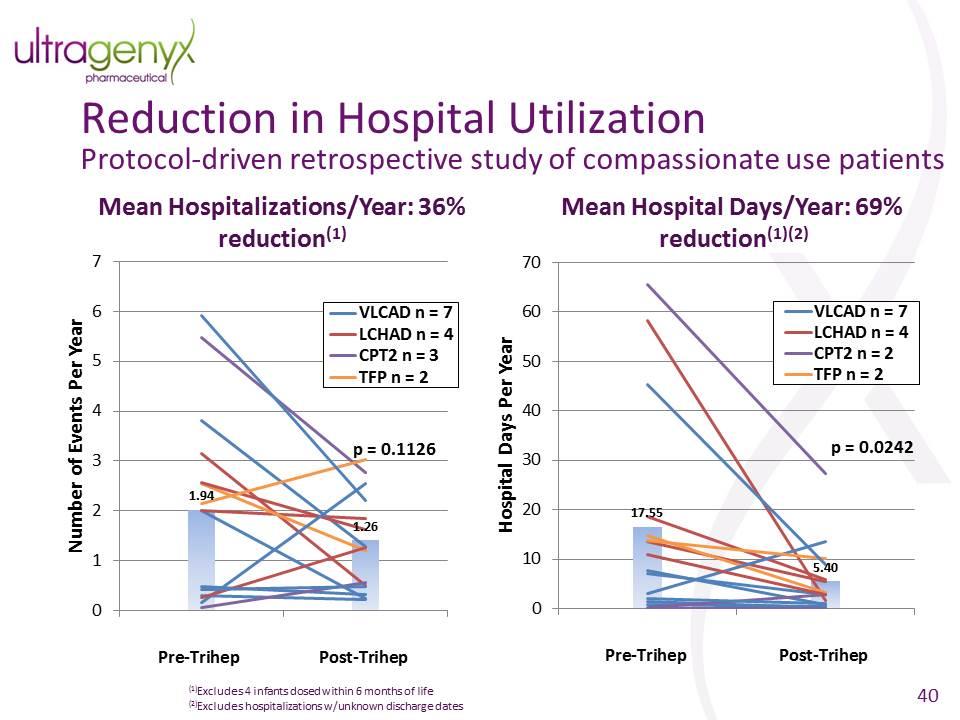
Mean Hospitalizations/Year: 36% reduction(1) Reduction in Hospital Utilization Protocol-driven retrospective study of compassionate use patients (1)Excludes 4 infants dosed within 6 months of life (2)Excludes hospitalizations w/unknown discharge dates Mean Hospital Days/Year: 69% reduction(1)(2)
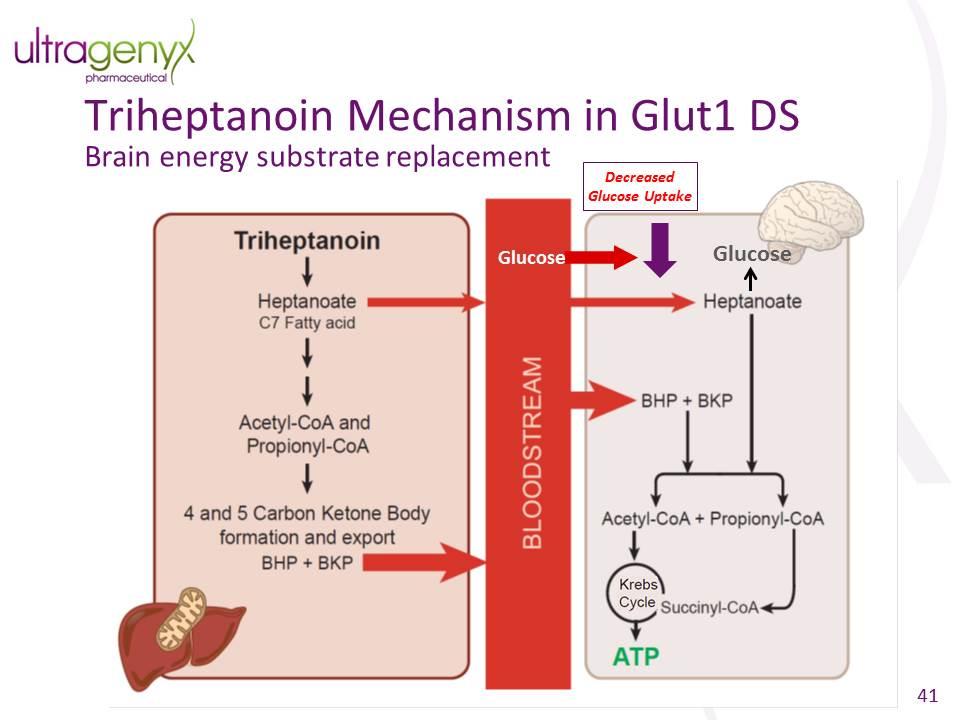
Triheptanoin Mechanism in Glut1 DS Brain energy substrate replacement Glucose Decreased Glucose Uptake Glucose
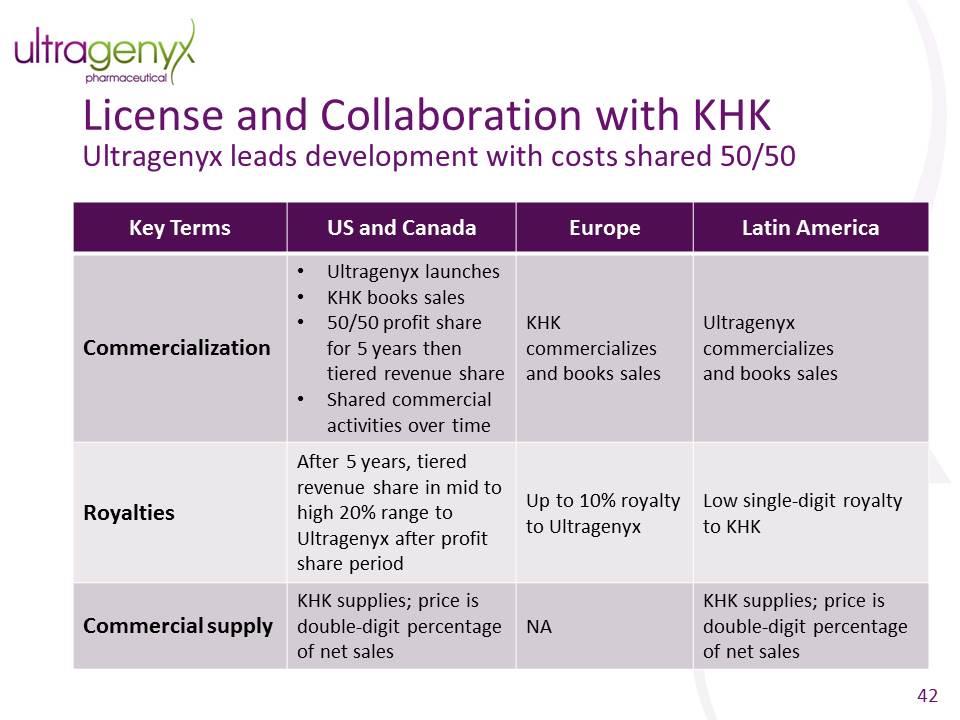
License and Collaboration with KHK Ultragenyx leads development with costs shared 50/50 Key Terms US and Canada Europe Latin America Commercialization Ultragenyx launches KHK books sales 50/50 profit share for 5 years then tiered revenue share Shared commercial activities over time KHK commercializes and books sales Ultragenyx commercializes and books sales Royalties After 5 years, tiered revenue share in mid to high 20% range to Ultragenyx after profit share period Up to 10% royalty to Ultragenyx Low single-digit royalty to KHK Commercial supply KHK supplies; price is double-digit percentage of net sales NA KHK supplies; price is double-digit percentage of net sales
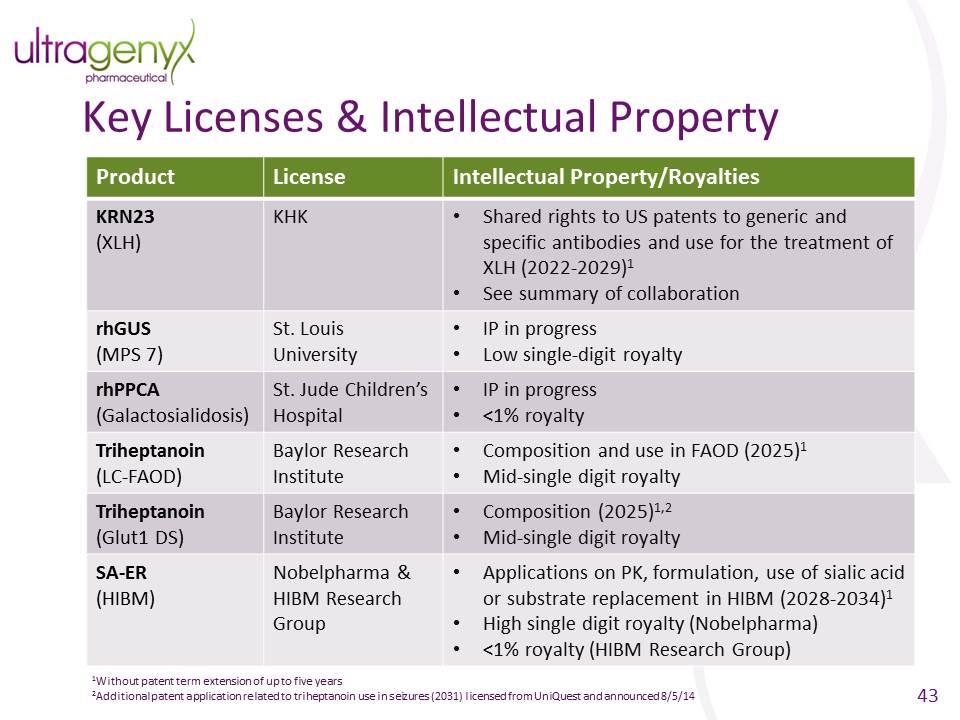
Key Licenses & Intellectual Property Product License Intellectual Property/Royalties KRN23 (XLH) KHK Shared rights to US patents to generic and specific antibodies and use for the treatment of XLH (2022-2029)1 See summary of collaboration rhGUS (MPS 7) St. Louis University IP in progress Low single-digit royalty rhPPCA (Galactosialidosis) St. Jude Children’s Hospital IP in progress <1% royalty Triheptanoin (LC-FAOD) Baylor Research Institute Composition and use in FAOD (2025)1 Mid-single digit royalty Triheptanoin (Glut1 DS) Baylor Research Institute Composition (2025)1,2 Mid-single digit royalty SA-ER (HIBM) Nobelpharma & HIBM Research Group Applications on PK, formulation, use of sialic acid or substrate replacement in HIBM (2028-2034)1 High single digit royalty (Nobelpharma) <1% royalty (HIBM Research Group) 1Without patent term extension of up to five years 2Additional patent application related to triheptanoin use in seizures (2031) licensed from UniQuest and announced 8/5/14
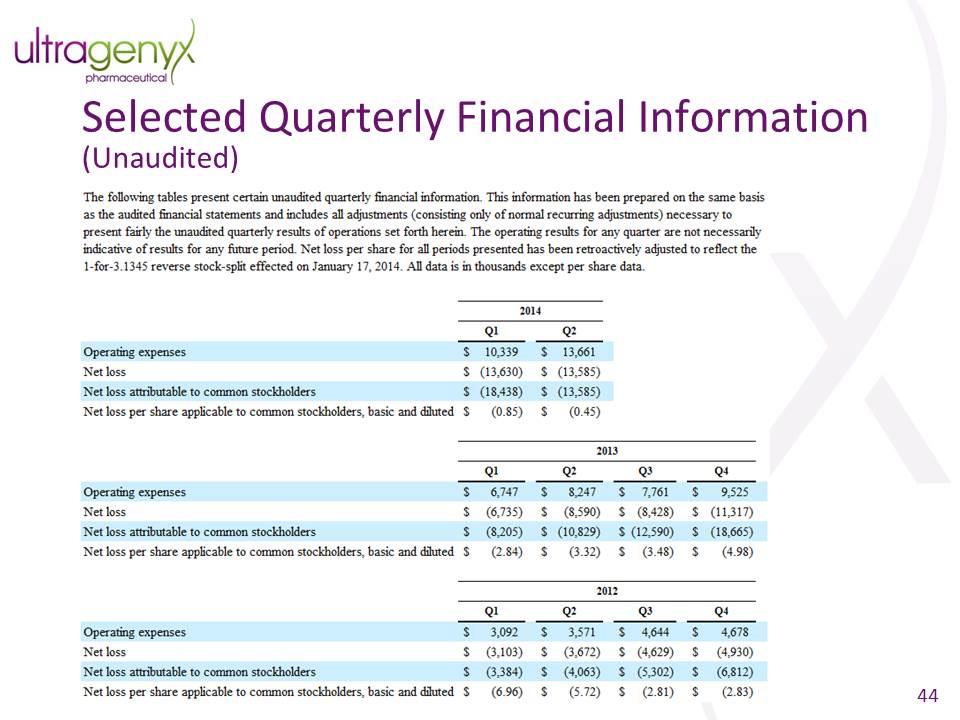
Selected Quarterly Financial Information (Unaudited)